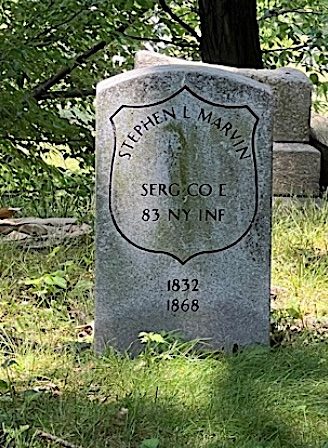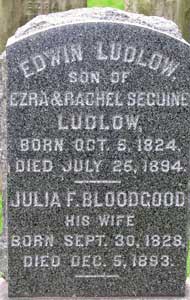
LUDLOW, EDWIN (1824-1894). Lieutenant colonel and major by brevet; captain, United States Volunteers Quartermaster’s Department. Born in New York, Ludlow enlisted as a captain on April 4, 1862, was immediately commissioned into the United States Volunteers Quartermaster’s Department and served there until his resignation on June 3, 1864. He was promoted by brevet to major and lieutenant colonel on March 13, 1865. His last residence was the Clarendon Hotel in Manhattan. Ludlow’s death was caused by diarrhea. Section 77, lot 4751.
LUDWIG, CHARLES (1842-1868). Private, 15th New York Heavy Artillery, Battery H. Originally from Germany, Ludwig enlisted as a private on February 10, 1864, at New York City, the same day that he mustered into Battery H of the 15th New York Heavy Artillery. On August 22, 1865, he mustered out at Washington, D.C. His last residence was in New York City. Ludwig fell victim of phthisis pulmonalis. Section 179, lot 11648.
LUFF, GEORGE T. (or F.) (1824-1898). Private, 12th Regiment, New York State National Guard, Company I. After enlisting as a private, Luff served for three months in Company I of the 12th Regiment when it was activated in 1862. He last lived in Putnam Country, New York, where he died of a cerebral hemorrhage. Section 57, lot 1992, graves 6 and 7.
LUKE, JOHN HENRY (1826-1881). Captain, 5th Regiment, New York State Militia, Company G. German-born, Luke enlisted at New York City as a captain on April 19, 1861, was commissioned into the 5th Regiment, also known as the Jefferson Guard, on May 1, and mustered out on August 7, 1861, at New York City. According to the Brooklyn City Directory for 1868, he was a grocer. His last address was on Myrtle Avenue in Brooklyn. First interred at Lutheran Cemetery after his death from consumption on March 14, 1881, he was removed to Green-Wood and interred there on June 11, 1887. Section 195, lot 25784.
Civil War Bio Search
LUNG, JESSE B. (1837-1907). Private, Pennsylvania Independent Militia; 97th New York Infantry. Lung was born in Pennsylvania and enlisted there as a private on September 15, 1862, mustering into “Van Valken” Company of the Pennsylvania Independent Militia the same day. He mustered out on September 24, 1862. He re-enlisted on September 1, 1864, mustered into the 97th New York (unassigned company), and was discharged on May 5, 1865, at Hart’s Island, New York Harbor.
In civilian life, Lung was a physician. In 1892, he applied for and received an invalid pension, certificate 1,028,954. Lung last lived at 1327 Eastern Parkway in Brooklyn. His death was caused by myocarditis. His widow, Mary C. Lung, applied for and received a pension in 1908, certificate 671,597. Originally interred in lot 8840 on February 12, 1907, his remains were moved to the current location on August 11, 1908. Section 132, lot 32850, grave 2.
LUQUEER, JR., FRANCES T. (1839-1903). Private, 7th Regiment, New York State Militia, Company K. A native of New York City, Luqueer joined the 7th Regiment in 1854 and went to work at his family’s harness-making business in 1857. During the Civil War, he enlisted at New York City as a private in 1861, mustered into the 7th Regiment on April 26, and mustered out with his company after 30 days on June 3. After the War, he served as captain of his company. He was a member of the Lafayette Post #140 of the Grand Army of the Republic and the 7th Veterans’ Association.
In civilian life, he was the president of R. S. Luqueer & Co., saddlers at 67 Murray Street in Manhattan, which was founded in 1814 and bore his grandfather’s name. Active in civic organizations, he belonged to the Lotos Club, the Hardware Club, and the New York Athletic Club. According to his obituary in The New York Times, he shot himself in the right temple after learning that he had but a few days to live because water had accumulated around his heart and his kidneys were failing. Another article about his death in the New York Evening Telegram reported that his nephew, Robert L. Major, who was caring for him, found Luqueer moaning and clutching a revolver after his suicide. Although many family members and business associates dismissed the idea that Luqueer’s death was a suicide, his nephew asserted that his uncle must have had “a fit of temporary insanity when he committed his rash act.” The New York Evening Post, in reporting on his death, confirms his Civil War service and states that he purchased the revolver just days before his death. He last resided with his sister’s family at 47 East 63rd Street in Manhattan. Section 35, lot 9305, graves 8 and 9.
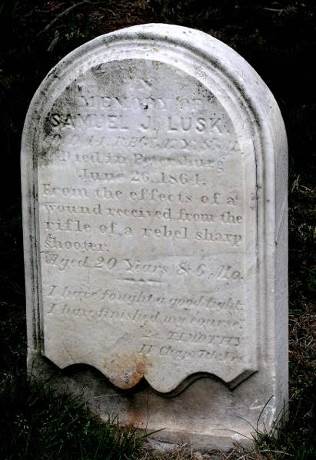
LUSK, SAMUEL (1843-1864). Private, 84th New York (14th Brooklyn) Infantry, Company D; 5th New York Veteran Infantry, Company H. He enlisted at Brooklyn on August 28, 1862, mustered into the 14th Brooklyn two days later, and transferred into the 5th Veterans on June 2, 1864. He was mortally wounded in the rifle pits at Petersburg, Virginia, on June 25, 1864, and died the next day at the Fifth Army Corps Hospital in City Point, Virginia. His funeral was at his mother’s home at 377 Carlton Avenue in Brooklyn and was attended by many of his colleagues from the Franklin Engine Company No. 3, of which he was a member, and veterans of the 14th Regiment. Interment at Green-Wood was on October 23, 1864. Section 40, lot 5888.
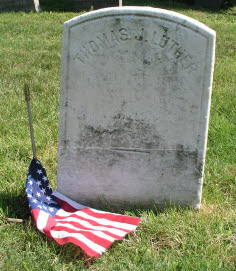
LUTHER, THOMAS J. (1842-1893). Musician, 5th West Virginia Infantry, Company B. After enlisting as a musician in the 5th West Virginia, he was discharged as a private. His last residence was 251 Court Street in Brooklyn. He died of meningitis. Section 135, lot 27263, grave 526.
LUTTON, CHARLES T. (1840-1905). Sergeant major, 4th United States Cavalry, Company B. Lutton was born in Belfast, Ireland. During the Civil War, he enlisted as a private on April 14, 1861, and mustered into Company B of the 4th Cavalry, Regular Army. As per his muster roll, he was 5′ 6″ tall with blue eyes and a ruddy complexion. He mustered out as a sergeant major on October 1, 1863. He then returned to the same company and mustered out at Nashville, Tennessee, on April 16, 1864, at the expiration of his term.
Lutton is listed as a carpenter in the 1876-1878 New York City Directory. At the time he mustered into the Farragut Post #75 of the G.A.R. on March 29, 1883, he was a carpenter who lived in Manhattan. The 1889-1890 New York City Directory lists him as a carpenter. In 1901, he applied for and received a pension, certificate 1,070,182. He last lived at 307 West 142nd Street in Manhattan. He died from Bright’s disease. In 1916, Johanna Hurd, applied for a widow’s pension, application 1,077,554, but it was never certified. Section 58, lot 1399.

LUTTRELL, THOMAS B. (1843-1902). Private, 71st Regiment, New York State National Guard, Company G. Born in New York, he enlisted as a private on May 28, 1862, at New York City, and mustered the same day into the 71st Regiment. He mustered out on September 2, 1862, at New York City. In 1901, he applied for a pension, application 1,270,953, but died of dysentery before it was approved. Luttrell’s last residence was 430 West 18th Street, Manhattan. His widow, Ellen Luttrell, applied for and received a pension in 1902, certificate 668,231. Section 183, lot 29688, grave 1.
LUTZ, CHARLES (1828-1868). Second lieutenant, 11th Regiment, New York State National Guard, Company H. Lutz enlisted on May 28, 1862, at New York City, was commissioned into the 11th National Guard that day, served with it at Harpers Ferry (now in West Virginia), and mustered out after three months on September 16 at New York City. When the regiment was reactivated the next year to meet the threat of General Robert E. Lee and his Army of Northern Virginia, he mustered in for 30 days service on June 16, 1863, served with the 11th near Harrisburg, Pennsylvania, and mustered out on July 20 at New York City. After the War, he lived in New York City. He died of stomach cancer. Section 68, lot 1571.
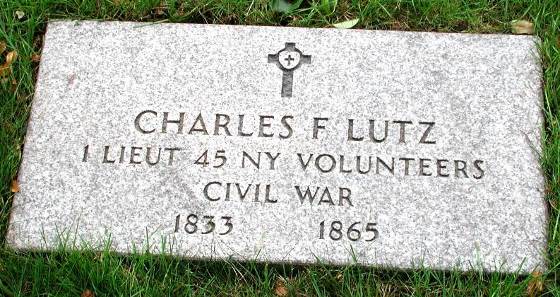
LUTZ, CHARLES F. (1833-1865). First lieutenant, 45th New York Infantry, Company D; 7th New York Veteran Infantry, Companies I and F. A German by birth, Lutz enrolled on September 2, 1861, at New York City, and mustered into the 45th New York as a first lieutenant on September 9. Almost one year later, he was discharged on September 1, 1862. He re-enlisted as a private at Tarrytown, New York, on October 4, 1864, and mustered into Company I of the 7th Veterans on that date. He was promoted to first sergeant at some point, to second lieutenant on January 11, 1865, and to first lieutenant on March 8, 1865, whereupon he was transferred to Company F. On August 4, 1865, he mustered out at Hart’s Island, New York Harbor. He was a resident of Spring Street in Manhattan at the time of his death from myocarditis. Section 127, lot 8899, grave 112.
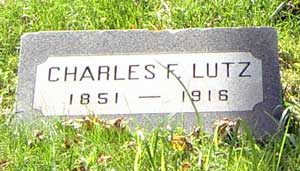
LUTZ, CHARLES F. (1851-1916). Unknown soldier history. He was a veteran and a member of the G.A.R., an organization of Civil War veterans. At the time of his death, he resided at 3615 Avenue D in Brooklyn. Section 199, lot 32034.
LUTZE, FREDERICK (1838-1924). Artificer, 1st New York Engineers, Company F. After enlisting as a private at New York City on November 16, 1861, he mustered into the 1st Engineers. During his service, he was promoted to artificer. Lutze mustered out on November 15, 1864, at Varina, Virginia. Section 2, lot 5499, grave 666.
LYALL, JOHN (1836-1876). Sergeant, 36th New York Infantry, Company D. Born in Canada, Lyall enlisted at New York City as a corporal on May 13, 1861, mustered into the 36th New York on June 17, and was promoted to sergeant exactly one year later. He mustered out on July 15, 1863. He last lived at 159 Franklin Street in Brooklyn. Lyall succumbed to consumption. Section 88, lot 12574.
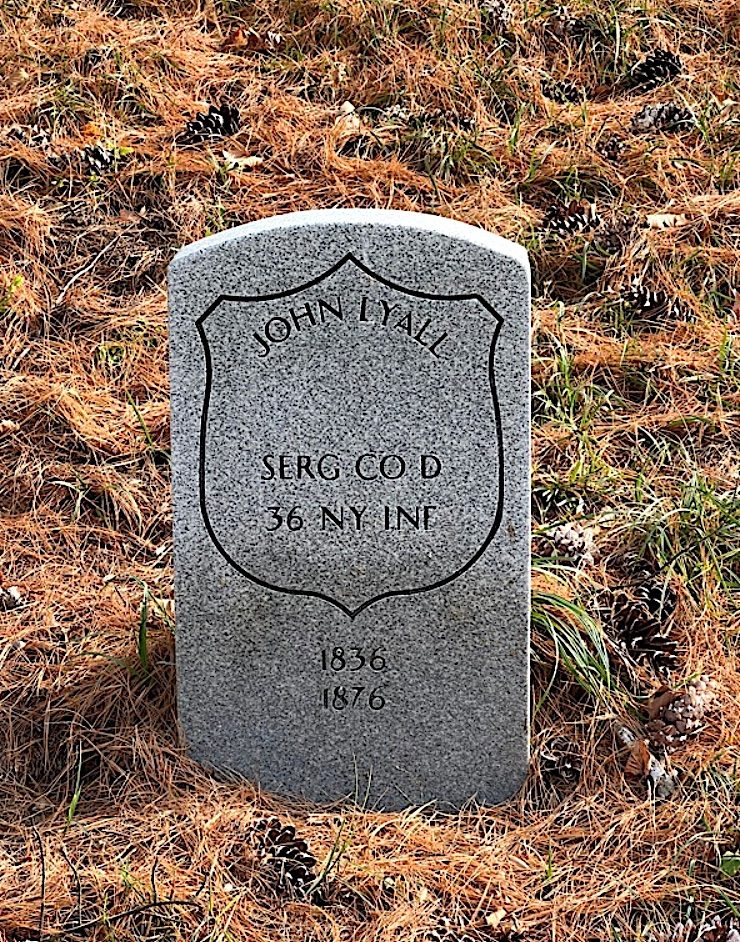
LYMAN, WILLIAM HENRY (1845-1909). Private, 22nd Regiment, New York State National Guard, Company C; 13th New York Heavy Artillery, Company A. Lyman served with the 22nd Regiment for three months in 1862 and with Company A of the 13th New York Heavy Artillery at some point during the Civil War. In 1890, he applied for and received an invalid pension, certificate 1,147,816. As per his obituary in the Brooklyn Standard Union, which confirmed his Civil War service, Lyman had been the staff photographer for the Buffalo Express and for the World Wide Magazine prior to his retirement. His obituary also notes that he was cited for bravery and had been promoted to captain of the 22nd before he mustered out at the end of the War. Lyman’s last residence was 408 Park Place in Brooklyn. His death was caused by pneumonia. Mary T. Lyman applied for and was granted a widow’s pension in 1909, certificate 681,392. Originally interred in lot 1634 on March 2, 1909, his remains were moved to the present location on April 22 of that year. Section 132, lot 32996, grave 2.
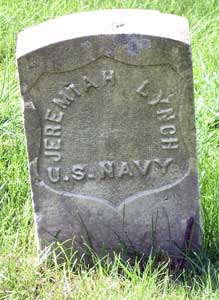
LYNCH, JEREMIAH (or JERRY) (?-1917). Seaman, United States Navy. Lynch, who was born either in Peekskill, New York, or in Boston, Massachusetts, enlisted at Boston as a landsman on May 11, 1861, when he mustered into the United States Navy that day. His discharge, a little more than a year later, took place on June 30, 1862. He re-enlisted at Boston on July 14, 1862, as an ordinary seaman, served aboard the USS Ohio, USS Colorado and USS Canandaigua. He was discharged as a seaman on May 11, 1865. His last residence was at 401 West 42nd Street in Manhattan. Section 3, lot 21025, grave 351.
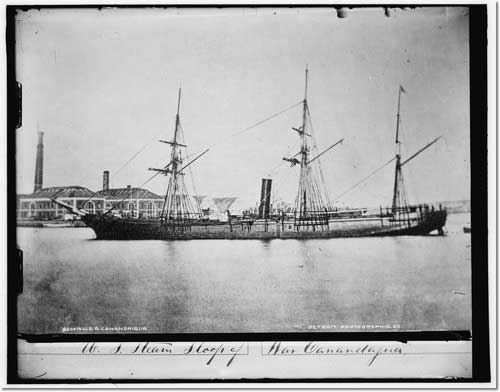
LYNCH (enlisted as STARKEY, THOMAS) (or SHERKEY, SKERKEY, SHEARKEY), THOMAS FRANCIS (1844-1905). Corporal, 99th New York Infantry, Companies I and C. According to a descendant, he was carried on the muster rolls as Thomas Starkey (his stepfather’s surname) or Thomas Sherkey, and was buried under the name of Thomas Lynch (birth name). After enlisting under the name of Thomas Sherkey as a private at New York City, his birthplace, on September 4, 1861, he mustered into Company I of the 99th New York two days later. He was 5′ 5½” tall with light complexion, blue eyes, brown hair and was a brass finisher by trade. The 99th had originally been the Union Coast Guard. He was promoted to corporal at some point and subsequently reduced in rank to private. Intra-regimentally transferred to Company C on June 15, 1864, he mustered out as a private on September 5, 1864, at New Berne, North Carolina, upon the expiration of his three year enlistment. Attendance records for the 99th show that for several periods during his service he was on the rolls of the USS West End; was stationed at Fort Dix in Suffolk, Virginia; at Fort Rodman in Portsmouth; and served in the Regiment Pioneer Corps.
While official documents of the New York Bureau of Vital Statistics and census records state his occupation as brass finisher, his descendant relates that Lynch and his grandfather worked undercover for the Wilkinson Detective Agency on the Du Pont explosion and barn burnings in 1890 and 1891, helping to get a conviction for the barn burnings but not for the explosion. He sought and received an invalid pension based on rheumatism and heart disease in 1899, certificate 1,028,522, resulting in a monthly pension of $6.00; later claims for an increase were based on impaired vision, and kidney and liver complaints. It was noted on his pension affidavit that he had tattoos on his right and left forearms . He last lived under the name of Sherkey at the Home for Soldiers and Sailors in Bath, New York. His death was caused by a cerebral hemorrhage. Section 124, lot 24135.
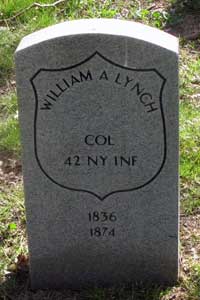
LYNCH, WILLIAM A. (1836-1874). Colonel, 42nd New York Infantry, Companies K and I. After working as a painter, Lynch joined the 42nd New York as a first lieutenant at Long Island on June 22, 1861, and was commissioned into Company K of the 42nd six days later. After a transfer to Company I on June 28 of that year, he rose to serve as captain upon his transfer back to Company K. He was summarily dismissed for being “more than useless” and absent without cause on April 23, 1862, but the dismissal was revoked a few weeks later on May 16. Lynch became lieutenant colonel of the 42nd on May 1, 1863, and its colonel in October 1863. He commanded the 42nd during the Mine Run Campaign in Virginia from November 26-December 2, 1863. He was wounded at Antietam, Maryland, and again at Cold Harbor, Virginia, on June 3, 1864.
Lynch later kept a saloon and operated a meeting place for veterans. In 1869, he applied for and was granted an invalid pension, certificate 107,905. He died in New York City, surrounded by many old comrades and friends. According to a descendant of David Hogg (see), he and Hogg were good friends as well as comrades in the 42nd New York and purchased cemetery lots next to each other. Lynch died of phthisis. His widow, Fanny Lynch, applied for and received a pension in 1875, certificate 428,027. Section 2, lot 7517.
LYNCH, WILLIAM HENRY (1834-1922). Private, 84th New York (14th Brooklyn) Infantry, Company D. After enlisting on April 18, 1861, at Brooklyn, he mustered into the 14th the next month on May 23, and mustered out at New York City on June 6, 1864. He applied for and was granted an invalid pension in 1904, certificate 1,089,864. According to his obituary in the Brooklyn Daily Eagle, Lynch belonged to the 14th Veterans’ Association, the Fighting 14th Infantry, the Veterans of Foreign War Post #546, and the Letter Carriers Mutual Benefit Association; members of those organizations were invited to attend his funeral. His last residence was 218 Avenue J in Brooklyn. Apoplexy was the cause of his death. Elizabeth F. Lynch, who is interred with him, applied for and received a widow’s pension in 1922, certificate 933,491. Section 203, lot 28551, grave 4.

LYON, GEORGE WILLIAM (1844-1905). Captain by brevet; first lieutenant and adjutant, 2nd Louisiana Cavalry; 1st Louisiana Cavalry; first lieutenant, 131st New York Infantry, Companies B and I; unknown rank, 37th Regiment, New York State National Guard. A native of New York City, Lyon was educated at the College of the City of New York and worked for a jewelry business before he began to study law. During the Civil War, he interrupted his studies and joined the 37th Regiment (rank unknown), mustering in on April 29, 1862. While on duty in Annapolis, Maryland, he was authorized to recruit troops by New York’s Governor Morgan. On August 20, 1862, he was commissioned into the 131st New York’s Company B as a first lieutenant. The 131st participated in the engagements of the Department of the Gulf and was at the siege of Port Hudson, Louisiana.

After declining a promotion to captain on September 8, 1863, Lyon was promoted to adjutant on December 10, 1863, effective upon his transfer that day to Company I. That same day he was discharged and commissioned into the Field and Staff of the 2nd Louisiana Cavalry (a Union regiment) as a first lieutenant and adjutant and served with them until he was transferred into the 1st Louisiana Cavalry on September 7, 1864, upon consolidation of the two units. During his time as adjutant, he was engaged in the “Sweet Potato” Raid in the fall of 1863, an expedition that attempted to destroy railroad communication between the gulf and the interior but ultimately failed because of heavy rains. While aide-de-camp to General Canby, he participated in the capture of Mobile, Alabama, and then served as aide-de-camp to General Sheridan, before being assigned to Canby as a volunteer aide. Lyon was promoted to captain by brevet on March 26, 1865, and discharged on September 7, 1865, after an attack of yellow fever.
Returning to the study of law, Lyon was admitted to the bar in New York State in May 1866 and opened a practice in the city. In 1872, he was counsel in the case against Boss Tweed, then served as assistant district attorney in New York from 1873-1882, was elected to the State Assembly as a Republican in 1886, but was defeated in his attempt to become a state senator a year later. From 1889-1893, he was surveyor of the port as an appointee of President Harrison, then returned to corporate practice. Active in many organizations, he was a member of the Freemasons, the Loyal Legion, the Republican Club, and the Lafayette Post #140 of the G.A.R. He last lived in Old Saybrook, Connecticut. He succumbed to chronic endocarditis. Section 119, lot 8215, grave 1273.
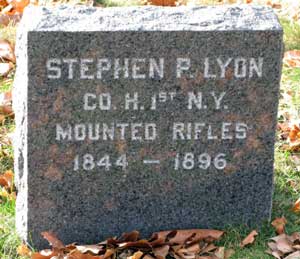
LYON, STEPHEN (1844-1896). Private, 1st New York Mounted Rifles, Companies M and H. Lyon, a New York State native, enlisted as a private at New York City and mustered immediately into Company M of the 1st New York Mounted Rifles on August 11, 1862. He transferred into Company H during his service, and mustered out on June 6, 1865, at Richmond, Virginia. His last residence was 305 West 43rd Street in Manhattan. Lyon was a victim of nephritis. Section 192, lot 23591, grave 4.
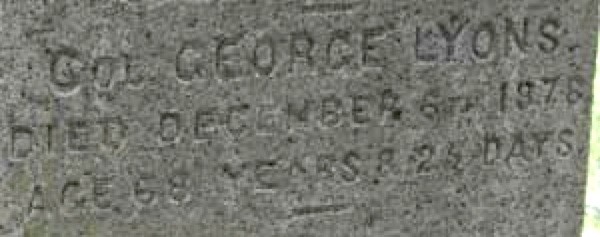
LYONS, SR., GEORGE (1810-1878). Colonel, 8th Regiment, New York State Militia. Following 18 years as commander of the New York State Fencibles, George Lyons served as colonel of the 8th New York State Militia from 1854-61. He enlisted as its colonel on April 23, 1861, was commissioned in two days later, and mustered out at New York City after three months on August 2. He was a merchant who last lived in Morrisania, New York. His death was caused by cirrhosis of the liver. George Lyons Jr. (see), who is buried in the same section and lot, was his son. Section 67, lot 2193.
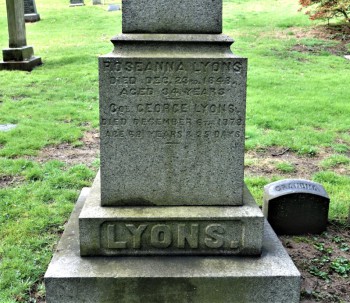
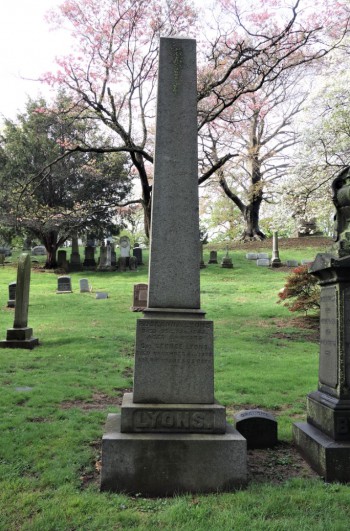
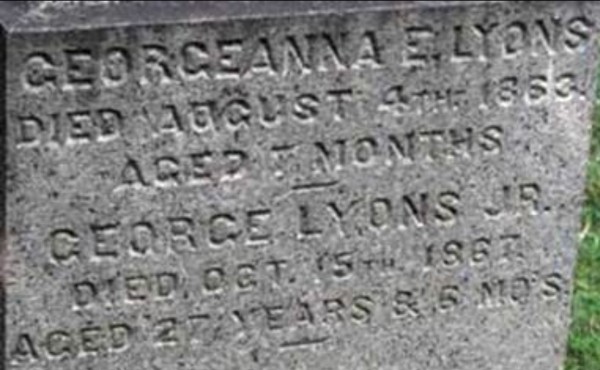
LYONS, JR., GEORGE (1840-1867). Paymaster, 8th Regiment, New York State Militia. A native New Yorker, he enlisted at New York City as an assistant paymaster on April 23, 1861, mustered into the Field and Staff of the 8th New York Infantry two days later, and was promoted to paymaster at some point before he mustered out on August 2 of that year at New York City. He last lived in Morrisania, New York, where he died of consumption. He was the son of George Lyons (see), who was colonel of the 8th, and who is buried in the same section and lot. Section 67, lot 2193.
LYONS, JOSEPH H. (1831-1868). Color sergeant, 25th New York Infantry, Companies A and G. Born in New York, Lyons enlisted as a private at New York City on May 11, 1861, and mustered into the 25th New York on June 14. At some point he was promoted to color sergeant, transferred to Company G on an unstated date, and was discharged for disability on December 15 of that year at Hall’s Hill, Virginia. His pension record indicates additional service in Company I of the 1st New York Marine Artillery but there are no details about that enrollment. In 1870, his mother applied for a pension, application 191,373, but there is no certificate number listed. His last residence was 107 Attorney Street in Manhattan. Section 145, lot 26568.
MABEN, JOHN CAMPBELL (1837-1924). Captain and assistant quartermaster, 1st & 3rd Corps, Army of Northern Virginia; sergeant, 12th Virginia Infantry, Company G, Confederate States of America. Originally from Petersburg, Virginia, he was educated at private school in Richmond, Virginia, and at Princeton University. On his maternal side, he was a descendant of Major General Alexander Spottswood, the colonial governor of Virginia from 1710-1722. After he enlisted as a private at Richmond on April 19, 1861, he mustered immediately into Company G of the 12th Virginia, Confederate States of America. On September 1, 1861, he was promoted to corporal of his company and became its sergeant on November 3. Maben was reduced to the rank of private on June 6, 1862. On July 20, 1864, he was promoted to captain and assistant quartermaster of the 1st and 3rd Corps, Army of Northern Virginia, to date from July 29, and according to a biographical sketch, was captain of cavalry. He was discharged from the Confederate Army on April 15, 1865, at Richmond.
A banker and financier, Maben moved to New York City in 1868. He later was the director of the Richmond-West Point Terminal Railway and Warehouse Company. In 1902, he became president of Sloss-Sheffield Steel & Iron Company whose main office was in Birmingham, Alabama. In addition, he was director of the Northern Alabama Railway Company. Active in the community, Maben was president of the New York chapter of the Confederate Veteran’s Camp and belonged to the Virginia Society of New York City. His last residence was at the Hotel Dennis in Atlantic City, New Jersey. He died of arteriosclerosis. Section P, lot 33611.

MACAULEY, CHARLES (1838-1883). Private, 83rd New York Infantry, Company G. Originally from Albany, New York, he enlisted as a private at New York City on May 27, 1861, and immediately mustered into the 83rd New York. In the draft registration for Canandaigua, New York, on June 30, 1863, he is listed as a 24-year-old farmer. As per his muster roll, he was detailed to the Medical Surveyor’s Department in Alexandria, Virginia, during his service. He mustered out on June 15, 1864, at Washington, D.C. As per his obituary in the New York Herald, he was a member of the John A. Dix Post #135 of the G.A.R.; comrades were invited to attend his funeral. He last lived in Asbury Park, New Jersey. His death was caused by heart disease. In 1899, his wife applied for and received a widow’s pension, certificate 566,050. A headstone was ordered for him from Vermont; that record indicates burial at Green-Wood where he was interred on April 4, 1900. Section ?, lot ?.
MACBETH, WILLIAM HENRY (1840-1916). Private, 6th Regiment, New York State Militia, Company A; 7th Regiment, New York State National Guard, Company F. Macbeth, originally from Manhattan, served with the 6th New York State Militia for three months in 1861. He also served for 30 days with the 7th Regiment in 1863. As per the census of 1880, the Brooklyn Directories of 1885 and 1904, and the census of 1910, he was a box maker. He applied for and was granted a pension in 1909, certificate 1,154,305. His obituary in the Brooklyn Standard Union, which confirms his Civil War service, notes that he was a long-time Brooklyn resident and a member of the Bushwick Avenue Methodist Episcopal Church. His last residence was 2503 Clarendon Road in Brooklyn. Shortly after his death from arteriosclerosis, Mary Macbeth, who is interred with him, applied for a widow’s pension, application 1,074,125, but there is no certification number listed. Section 174, lot 17862, grave 4.
MACDONALD (or McDONALD), ROBERT M. (1844-1882). Corporal, 139th New York Infantry, Company E. Born in Scotland, he enlisted at Brooklyn as a private on August 23, 1862, and mustered in on September 9. Promoted to corporal on August 27, 1864, he served with the regiment until the end of the War. Among the battles that his regiment fought included these in Virginia: Williamsburg, Cold Harbor, Wilderness, Petersburg, Drewry’s Bluff, Swift Creek, Fair Oaks, Chickahominy Swamp, Charles City, and Richmond. His regiment was present at Lee’s surrender. He mustered out at Richmond, Virginia, on June 19, 1865. A bullet remaining in his foot from a wound sustained during the conflict was removed a few years before his death.
The Brooklyn Directory of 1873 and the 1880 census indicate that Macdonald was a painter. In 1879, his application for an invalid pension was approved, certificate 271,251. He joined the Rankin Post #10 of the G.A.R. in 1879 and was an officer of the day in that organization. His obituary in the New York Tribune reports that his burial would include military honors by the Rankin Post. Macdonald last resided at 557 Union Street, Brooklyn. He died of pericarditis. In 1890, Josephine Macdonald applied for and received a widow’s pension, certificate 315,805. Section D, lot 19604.

MACFADYEN (or MacFADYEN, McFADYEN), DAVID B. (1831-1894). Sergeant, 79th Regiment, New York State Militia, Company F. A native of Scotland, Macfadyen enlisted as a sergeant on May 13, 1861, and mustered into Company F of the 79th New York State Militia where he served as a right general guide, as confirmed by the inscription on his tombstone. The right general guide had to assume fixed positions aligned to the color-bearer in marching formations. He mustered out on August 13, 1861.
As per the 1870 and 1880 censuses and the G.A.R. sketchbook, Macfadyen was a bookbinder. Remaining active in military affairs, he mustered into the Michael W. Wall Post #623 of the G.A.R. in 1881. The 1890 Veterans Schedule confirms his Civil War service. He last lived at 38 Wilson Street in Brooklyn. His death was attributed to pneumonia. Section 121, lot 11189, grave 100.
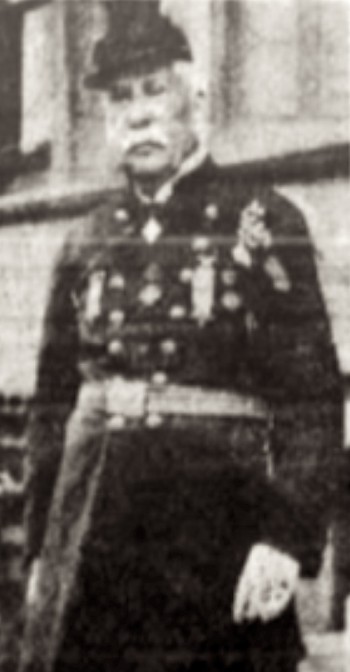
MACGOWAN, ELI F. (1844-1928). Private, 73rd New York Infantry, Company F. A Manhattanite by birth, Macgowan’s ancestors were Scottish shipbuilders. During the Civil War, he enlisted at New York City as a private on May 17, 1861, and mustered into the 73rd New York on July 10. He was wounded at the Battle of Five Forks, Virginia, on April 1, 1865, but rejoined his regiment and was discharged on June 10, 1865, at Washington, D.C.
The 1870 census states that he was an engineer living in Newtown, Queens; the 1880 census lists him as a dockman. An article in the New York Herald on October 14, 1886, reports that Macgowan, the superintendent of the East River Ferry Company, appeared in the Court of Common Pleas seeking $10,000 in damages from James Duff, the proprietor of the Standard Theater, after Macgowan and his wife were made to give up their orchestra seats in the theater on December 27, 1884. The jury ruled in Macgowan’s favor but he was awarded only $103 in damages.
As per his obituary in the Brooklyn Daily Eagle, which confirms his Civil War service, Macgowan had been the superintendent of the East River Ferry Company for twenty-two years. A Freemason, he was also a member of the Ulysses S. Grant Post #328 of the G.A.R. In 1896, his application for an invalid pension was granted, certificate 935,180. The 1900 census reports that he was an inspector of docks; the 1910 and 1920 censuses report that he was a city depot inspector. He last resided at 1234 Pacific Street in Brooklyn. He died of a cerebral hemorrhage in Springdale, Connecticut, at the home of his son. Shortly after his death, Adela Macgowan, his wife of sixty-two years who is interred with him, applied for and received a widow’s pension, certificate a-10-12-28. Section 128, lot 37013.
MacGREGOR (or McGREGOR), SAMUEL H. (1840-1911). Sergeant, 133rd New York Infantry, Company I. MacGregor, a native of Long Branch, New Jersey, enlisted at Brooklyn as a private on August 24, 1862, and mustered into the 133rd New York on September 24. As per his muster roll, he was a paper ruler, a skilled craftsman who operated a machine that put lines on paper. He had blue eyes, light hair and a fair complexion. He rose to the rank of sergeant before being discharged on June 30, 1864, at Morganza, Louisiana. According to his pension record, he also served in the United States Navy as an ordinary seaman as of June 1864. He served onboard the USS Princeton, USS Pinola, USS Portsmouth, and the USS J. P. Jackson.
The 1880 census and the 1881 Jersey City, New Jersey Directory list MacGregor as a paper ruler. The 1890 Veterans Schedule, which confirms his Civil War service, reports that he suffered two flesh wounds while serving with the 133rd. In 1891, he applied for an invalid pension from the U.S. Army, application 1,064,443, but the certificate number is not listed. However, he did receive a pension from the Navy, certificate 31,138. The 1900 census indicates that he was a proprietor in Jersey City. His last residence was 97 Charles Street in Jersey City, New Jersey, but he died from “intermittent fever” at the Soldiers Home in Kearny, New Jersey. After his death in 1911, Maria MacGregor, who is interred with him, applied from a widow’s pension from the Army, application 968,586, but no certificate number is specified. She did receive a widow’s pension from the U.S. Navy, certificate 784,484. Section 84, lot 6118, grave 7.
MACHADO, JOHN ALBERT (1817-1894). Slavetrader. A native of the Azores, Machado immigrated to the United States in the late 1840s and became a naturalized citizen in 1853. From his office at 153 Pearl Street in Manhattan, he engaged in legitimate and illegitimate trade with West Africa which was at its height from the late 1850s through 1861. On May 11, 1858, he claimed that he was owed compensation for injuries and losses when his ship, the Thomas Watson, was captured by the HMS Bloodhound off the coast of Africa. The charge was detaining a colored British subject with the view of selling him as a slave. Infamous for his involvement in the slave trade, Machado oversaw the outfitting of barques that brought slaves from Africa to Cuba. He, like others in the trade, used obscurity to fit ships, haul cargo and recruit crews as well as bribery of deputy marshals, assistant district attorneys and customs officers. Admiralty lawyers, whose offices were on Wall Street, became adept at handling cases of those who ran afoul of the laws banning the slave trade.
In April 1862, Secretary of State William Seward signed a pact with the British, the Lyons-Seward Treaty. By this pact, the United States and Britain policed each other’s trans-Atlantic shipping of slaves; it ultimately proved effective in ending the trans-Atlantic slave trade. One article in The New York Times reported that the schooner George J. Townsend, owned by an American citizen from Hempstead, New York, and chartered to Machado, was outfitted as a slave ship and bound for Gambia in Africa. The vessel, which was docked at Pier 48 on the East River, was taken into custody by Mr. Hillyer, the United States marshal.
As per another article in The New York Times on September 21, 1862, the United States Marshal had tried, unsuccessfully, to prove that Machado was the ringleader of a slave trade, and, although imprisoned, Machado was freed. The article goes on to report that the marshal had learned through an informer the whereabouts of Captain John Perkins of the barque Mary Francis, one of Machado’s slaveships. Perkins testified that he took command of the Mary Francis at Wilmington, North Carolina, in 1860, and together with Mrs. Mary Jane Watson, a paramour of Machado in whose name the business was handled, outfitted the vessel for its trip to Africa. Perkins was paid $5,000, with a $1,000 bonus for carrying out the voyage. Ultimately, that journey was successful and the ship returned to Cuba in the spring of 1861 with its cargo of slaves. Mrs. Watson, who traveled to Cadiz, Spain, was no longer alive, and the evidence was enough to re-arrest Machado who was heading for Cuba on the Columbia, a steamer. That arrest, together with the Seward-Lyons Treaty, and changes in public opinion helped break up the illegal slave-trading activities in New York City. He last lived at 438 Prospect Avenue in Brooklyn. He died of Bright’s disease. Section 23, lot 3987.
MACHIN, CHARLES HENRY (1840-1912). First lieutenant, 2nd New York Heavy Artillery, Company D; private, 1st Illinois Light Artillery, Company B. A native of Middletown, New York, Machin was the son of the Reverend Charles Machin of Chicago, who was the chaplain of the 140th New York Infantry during the Civil War. According to his obituary in the Brooklyn Daily Eagle, Charles Henry Machin, who was a law student at the onset of the Civil War, enlisted in Company B of the 1st Illinois Artillery on an unknown date and fought in Missouri at Bird’s Point and Belmont, two of the first battles under the command of General Ulysses S. Grant. He re-enlisted and was commissioned into the 2nd New York Heavy Artillery on May 28, 1862, at Albany, New York, as a second lieutenant, and fought at Second Bull Run, Virginia. After being promoted to first lieutenant on January 1, 1863, he mustered out on April 29, 1863. According to his obituary in The New York Times, he was wounded at Fort Donelson, Tennessee. The Brooklyn Daily Eagle notes that he was in the Quartermaster’s Department at the end of the War and then was the head of the Bureau of Corporations in the Treasury Department in Washington, D.C.
A lawyer in New York City beginning in 1866, Machin’s offices were in the Evening Sun Building for the last thirty-six of his forty-six years of practice. In 1879, he applied for and received an invalid pension, certificate 190,037. Machin last resided at 264 Gates Avenue in Brooklyn. His widow was awarded a pension in 1912, certificate 742,476. Section L, lot 18110, graves 1-4.
MACK, JOHN (1822-1897). Corporal, 65th New York Infantry, Company B; private, 67th New York Infantry, Companies G and B. Originally from London, England, Mack enlisted at Brooklyn as a private on June 21, 1861, and mustered into Company G of the 67th New York on August 31. As per his muster roll, he was an engraver who had blue eyes, light hair and a fair complexion. He re-enlisted on December 25, 1863, was transferred intra-regimentally to Company B on June 19, 1864, and transferred into Company B of the 65th New York on September 1, 1864. Mack was promoted to corporal on or about November 15, 1864, and mustered out at Hall’s Hill, Virginia, on July 17, 1865.
Mack’s application for an invalid pension was approved in 1875, certificate 137,567. His pension, originally $4 per month, was later raised to $12 per month. Upon his admission to the Soldiers’ and Sailors’ Home in Bath, New York, on October 24, 1882, he indicated that he suffered a flesh wound at the Battle of Cold Harbor, Virginia, in June 1864, and also suffered from rheumatism. His admission paperwork indicates that he was an engraver. He was discharged to his Brooklyn home on October 31, 1889, but was readmitted to the Soldiers’ and Sailors’ Home on October 12, 1895, where he died of general debility on February 24, 1897. Section 2, lot 5499, grave 814.
MACKAY (or MACKEY), THOMAS (1835-1893). Private, 42nd New York Infantry, Company K; 82nd New York Infantry, Company E; 59th New York Infantry, Company I. Mackay enlisted as a private on August 6, 1861, at New York City, and mustered into the 42nd New York three days later. On June 28, 1864, he transferred into Company E of the 82nd New York remaining less than a month before his transfer into the 59th New York on July 10. Mackay’s date and method of discharge are not known. He last resided at 138 23rd Street in Brooklyn. Section 196, lot 26067.

MACKELLAR (or McKELLER, McKELLAR), ROBERT F. (1838-1905). First lieutenant, 48th New York Infantry, Companies C, A, I, and K; private, 13th Regiment, New York State Militia, Company C. A stone-cutter, born in Scotland, 5′ 11″ tall with fair complexion, brown hair and blue eyes, he enlisted as a private at Brooklyn for a three month tour of duty with the 13th New York State Militia on April 23, 1861, and mustered into Company C. He mustered out on August 6, 1861. On September 5, 1861, he re-enlisted at Brooklyn as a private, and mustered into Company C of the 48th New York Infantry five days later with the rank of sergeant. During January and February 1862, he was absent from his regiment on recruiting duty.
In June 1863, Mackellar was promoted to first sergeant and transferred to Company A. He was slightly wounded during operations on Morris and Folly Islands, South Carolina, between July 10 and 20, 1863, and was wounded in the foot in the second attack on Fort Wagner on Morris Island on July 18. He returned to New York City on furlough in September and October and rejoined his regiment on November 18. He was promoted to second lieutenant on March 8, 1864, effective upon his transfer to Company I at Hilton Head, South Carolina, on April 12. Mackellar also served in Company K.
In May 1864, he became disabled at Bermuda Hundred, Virginia, suffering from eye problems, and was under a surgeon’s care. He was promoted to first lieutenant on June 1, 1864, and contracted an eye infection while the regiment was stationed near Petersburg, Virginia. From July 6 to 12, he was treated for debility at the Depot Hospital at Point Lookout, Maryland. From August 24 to 29, 1864, he was treated in the 10th Corps Hospital at Point of Rocks, Maryland, diagnosed with amourosis (sudden loss of vision). He returned to duty but continued to suffer eye problems and was discharged for disability on September 26, 1864, at City Point, Virginia. Among the battles in which he fought are: Morris Island, South Carolina, Olustee, Florida; and the following Virginia engagements: Fort Darling, Drewry’s Bluff, Bermuda Hundred, Cold Harbor, Mine Explosion, Deep Bottom, Strawberry Plains, Foster’s Plantation Petersburg, and Newmarket Heights, where he was wounded.
After the Civil War, Mackellar returned to Brooklyn and owned and operated a marble yard on Fort Hamilton Avenue opposite the entrance to Green-Wood Cemetery that specialized in monumental granite work. He was a member of the Grand Army of the Republic’s Ulysses S. Grant Post #327. He served as a body guard for President Ulysses S. Grant and was part of the honor guard unit at Mt. McGregor, New York, after Grant’s death and remained on this detail at Albany, City Hall and Riverside Park, New York. In 1886, he applied for an invalid pension citing poor eyesight that was at first disputed but eventually approved under certificate 1,085,801. He last lived at 202 17th Street in Brooklyn. His death was caused by nephritis. His widow, Marie S. Mackellar, applied for and received a pension in 1908, certificate 644,361. Section 31, lot 7748, grave 5.
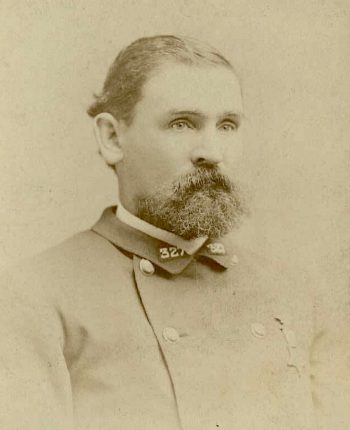
MACKENZIE, MORTIMER LIVINGSTONE (1843-1874). Private, 7th Regiment, New York State National Guard, Company G. A New York City native, Mackenzie enlisted as a private at New York City in 1863. He mustered into Company G of the 7th Regiment for its 30 day activation. He was discharged at the expiration of his enlistment. According to the 1870 census, he was employed as a shipping merchant. Mackenzie served on the board of directors of the Atlantic and Great Western Railroad and was also an autograph collector whose compilation of 500 foreign and American autographs was sold at auction in 1886. According to his obituary in the New York Herald, he was a Freemason and member of the American Numismatic and Archeological Society. Members of those associations and comrades from the 7th Regiment were requested to attend his funeral at his father’s residence at 8 West 48th Street in Manhattan. He succumbed to phthisis. Section 173, lot 20198.

MACKENZIE (or McKENZIE), RODERICK (1830-1885). Private, 79th New York Infantry, Companies F and A. A New York City native and a carpenter by trade, Mackenzie enlisted and mustered into the 79th New York, familiarly known as the Highlanders, on October 23, 1861. He was one of four brothers and two brothers-in-law who served in the Civil War. As per a descendant, he joined a younger brother, Lachlan, in the South Carolina Islands and fought there at the Battle of Secessionville at James Island on June 16, 1862, and then at Second Bull Run, Virginia, on August 28-30, 1862. He was treated for disease at a hospital at Washington, D.C., before rejoining his regiment in October 1862. He then fought at the Battle of Fredericksburg, Virginia, from December 11 through December 15, 1862. In April 1863, Mackenzie was suffering from nephritis and was hospitalized in Kentucky and Indiana before returning to his unit in East Tennessee in October of 1863.
Mackenzie was one of five men from the 79th who were wounded at the Battle of Fort Sanders, Tennessee, on November 29, 1863. Suffering from a flesh wound to the back of his neck from a Minie ball, he was hospitalized at Knoxville Courthouse Hospital from November 29, 1863, until January 31, 1864. Coincidentally, his brother Lachlan was in another Knoxville hospital suffering from bronchitis; on January 3, 1864, Lachlan was transferred to the Courthouse Hospital and the brothers were reunited. Sadly, Lachlan died in the hospital from chronic diarrhea on January 27, 1864, while Roderick was still a patient there. Roderick Mackenzie was readmitted to the same hospital from February 1 to February 7, 1864. Mackenzie then fought in Virginia at the Battle of the Wilderness (May 5-7, 1864) and the Battle of Spotsylvania (May 8-21, 1864). He was transferred intra-regimentally to Company A on May 31, 1864.
Although the 79th mustered out as a unit in May of 1864, those owing time, like Roderick Mackenzie, were allowed to return to New York on furlough. On June 11, 1864, he was admitted to Ladies Home General Hospital in New York City where exploratory surgery was performed because his wound did not heal properly. Although Mackenzie’s official muster out date was October 24, 1864, denoting three years of service, and the order for his muster out was signed by Dr. Alexander B. Mott (see), Mackenzie remained in the hospital until March 29, 1865. His muster roll for July 14, 1865, from Alexandria, Virginia, notes that he was discharged from the hospital for disability. His application for an invalid pension was approved in 1869, certificate 102,267.
According to the 1870 census, Mackenzie was living in Manhattan with his father (who was listed as a “gent”) and siblings and working as a carpenter. In the 1876 Brooklyn Directory, he was listed as a clerk living at 53 Sterling Place. Mackenzie last lived at 284 West 11th Street in Manhattan with his sister and her husband, Charles Sanderson (see), who was the chief bugler for the 79th Regiment. He died from phthisis at St. Vincent’s Hospital in New York and is interred in a lot next to that of the Sandersons. Section 183, lot 10976.
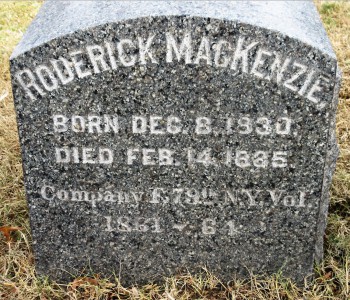
MACMURDO (or MacMURDO, McMURDO), RICHARD CHANNING (1834-1914). Captain and assistant quartermaster, Ordnance Department, Confederate States of America; second lieutenant, Virginia Letcher Light Artillery; private, 21st Virginia Infantry, Company F. Born in Richmond, Virginia, Macmurdo enlisted as a private on May 18, 1861, at Game Point, Virginia, and mustered immediately into the 21st Virginia Infantry. During that tour of duty, he was listed as sick on September 8, 1861, at Huntersville, Virginia. On December 13, 1861, he wrote to Major General Leonidas Polk, C.S.A., requesting a position above the rank of private recounting his experience on detail in the Pay Department under the supervision of the quartermaster and suggesting that he might be a commissary. Asking for a response to his father and citing greetings from his mother, it is apparent that he was acquainted with Polk. Promoted to sergeant on March 29, 1862, he was transferred that day into the Virginia Letcher Light Artillery, and rose to second lieutenant on August 15, 1862. On December 13, 1862, his horse was killed in action at Fredericksburg, Virginia, prompting him to file an affidavit that eventually awarded him $250 for the said horse that was purchased in August 1862. Macmurdo was wounded in the left hand at Chancellorsville, Virginia, on March 5, 1863.
After a promotion to captain on July 1, 1863, Macmurdo was transferred to the Ordnance Department. On August 8, 1863, he was in charge of the Confederate States Ambulance Shops at Richmond, Virginia, reporting to Major Robert Archer, and on March 28, 1864, wrote that his office was on the South Side Dock opposite Libby Prison. Given additional responsibilities on May 16, 1864, he was assigned to duty with Brigadier General G. W. C. Lee. Lee wrote, “…This assignment will add much to the comfort and efficiency of the troops for local defense, and will not, I think, interfere materially with Captain MacMurdo’s present duties….” On August 3, 1864, he was recommended for a promotion to quartermaster by General G. W. C. Lee, “…His promotion would place him upon an equal footing with other brigade quartermasters, as regards rank, and would be bestowed upon a meritorious officer….” That letter also noted that he rose through the ranks from the beginning of the War and that he fought at Chancellorsville and Gettysburg. In a letter written on January 16, 1865, Macmurdo wrote that 264 ambulances were manufactured in 1864, 25-30 days of manpower were lost to high water in addition to $3,000-4,000 worth of supplies including 5,500 spokes, 20 hubs, 6,500 feet of lumber, 30 gallons of oil, and 20 bins of coal. He suggested that the production continue at Richmond since there were supplies on hand for a year as well as forges in the blacksmith shop. On February 1, 1865, he was relieved of duty in charge of the Ambulance Shops and was assigned as a paymaster of the division. He took an oath of loyalty after his parole on April 24, 1865.
In 1870, the census showed him as living in Norfolk, Virginia. In civilian life, he worked in the hat business and was living in Great Neck, Long Island, and then was employed in real estate in Arlington, New Jersey. He last lived at 308 Beach Street in Arlington, New Jersey. Section 10, lot 5733.

MACNIFF (or McNIFF), LOTHIAN (or LATHIAN) (1846-1907). Private, 84th Regiment, New York State National Guard, Company A. Born in Tivoli, New York, he was a drummer in the 84th New York National Guard serving for 30 days in 1863. In 1864, he served as a private in the 84th New York National Guard for 100 days. This regiment was raised in New York City on July 12, 1864, and mustered out on October 29. His last service was with Sheridan in the Shenandoah Valley.
After the Civil War, he was employed by the commission firm of Dunham & Buckley. He is listed in the 1880 census as a store clerk. He applied for an invalid pension in 1904, application 1,321,430. A member of the Winchester Post #197 of the G.A.R., he also belonged to the Long Island Council, Royal Arcanum. A secretary and librarian for many years at the Sunday school of Lafayette Avenue Presbyterian Church, he died of apoplexy at his home, 440 Lafayette Avenue in Brooklyn. Section 173, lot 21653.
MACOMBER, BENJAMIN (1801-1861). Major, United States Marine Corps. Macomber, a native of Rhode Island, began serving in the Marine Corps as a second lieutenant on March 28, 1820. He rose to first lieutenant on April 2, 1823, and to captain on January 8, 1838, having previously been brevetted to captain on April 2, 1833. He became a major on January 7, 1859. His last address was in New York City on Fifth Avenue and 25th Street. He died on May 29, 1861. Section 56, lot 2546.
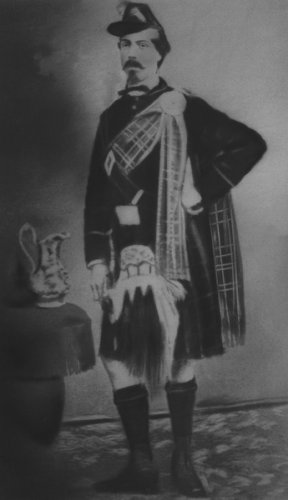
MACPHERSON (or McPHERSON), JOHN ANGUS (1834-1891). Second lieutenant, 79th New York Infantry, Company A. Macpherson, a native of Scotland, immigrated to the United States about 1850. According to a descendant who researched his military service, he was a founding member of the 79th New York State Militia which was active in New York City between 1859 and 1861. In May 1861, under sponsorship of the New York Caledonian Club, the members of this militia formed the 79th New York Infantry, known familiarly as the Highlanders.
Macpherson enlisted at New York City on May 28, 1861, and was commissioned as a second lieutenant that same day. The 79th proceeded to Washington, D.C., where they joined the Army of Northeastern Virginia (1st Division, Third Brigade, under Colonel William T. Sherman). Following an engagement with the Confederate Army at Blackburn’s Ford, Virginia, on July 18, 1861, Macpherson became seriously ill and was taken to the hospital at Centerville. He was discharged on July 29th as a result of that illness.
After returning to New York City, Macpherson resumed his occupation of dancing master. Previously, he had schools in New York City and, for a short time, in Chicago where he taught traditional Scottish Highland dances as well as the popular social dances of the day. His brother-in-law, William Opdyke (see), is buried near him at Green-Wood. He died of Bright’s disease at his home, 313 Madison Street, in New York City. His widow applied for a pension after his death, application 554,188; however, it was denied because the cause of death, Bright’s disease, was unrelated to his Civil War service. Section 114, lot 8999, grave 888.
MADDEN, JAMES (1825-1899). Private, 158th New York Infantry, Company D. Madden, who was originally from Ireland, enlisted at Brooklyn as a private on November 11, 1863, and mustered into Company D of the 158th New York that same day. He was wounded at Petersburg, Virginia, on April 2, 1865, and was discharged for disability on September 5, 1865, at Fort Monroe, Virginia. His last residence was on West 16th Street in Manhattan. He died of complications from a fractured leg. Section 127, lot 3139, grave 135.
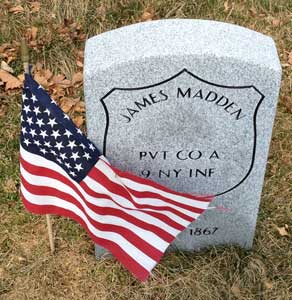
MADDEN, JAMES (1844-1867). Private, 9th New York Infantry, Company A. A native New Yorker, he enlisted there as a private on August 6, 1861, mustered immediately into the 9th New York, and was discharged for disability on December 12, 1862, at Fredericksburg, Virginia. He last lived at 24 Oliver Street in Manhattan. His death was attributed to phthisis. A government-issued stone was ordered for his grave early in the 20th century. Section 115, lot 13536 (Soldiers’ Lot), grave 107.
MADDOCK, WILLIAM B. (1819-1888). Private, 174th New York Infantry, Company G. Born in England, he enlisted at New York City as a private on October 9, 1862, and mustered into the 174th New York eight days later. Other details of his service are not known. He last lived at 146 Bergen Street in Brooklyn. He succumbed to cirrhosis of the liver. Section 148, lot 23095.
MAGEE (or McGEE), JOSEPH (1829-1865). Private, 51st New York, Company G; 13th New York Veteran Reserve Corps, Company F. Born in Ireland, he enlisted and mustered into the 51st New York at Brooklyn on October 8, 1861. His muster roll reports that he was also borne on the rolls as Joseph McGee. He was wounded in the right leg at the Battle of Second Bull Run, Virginia, on August 30, 1862, and transferred into the Veteran Reserve Corps on July 8, 1863. He succumbed to consumption on January 9, 1865, at his residence at 40 Fleet Street in Brooklyn. On February 23, 1865, Mary Magee applied for and received a widow’s pension, certificate 88,158. His minor children received a pension in 1869, certificate 126,523. Section 115, lot 13536 (Soldiers’ Lot), grave 99.
MAGILL, WILLIAM C. (1843-1875). Private, 47th Regiment, New York State National Guard, Company E. Born in Ireland, he enlisted as a private at Brooklyn on May 27, 1862, mustered into the 47th Regiment the same day, and mustered out at Brooklyn on September 1, 1862. He last lived at 5 East 76th Street in Manhattan. Section B, lot 8575, grave 1217.
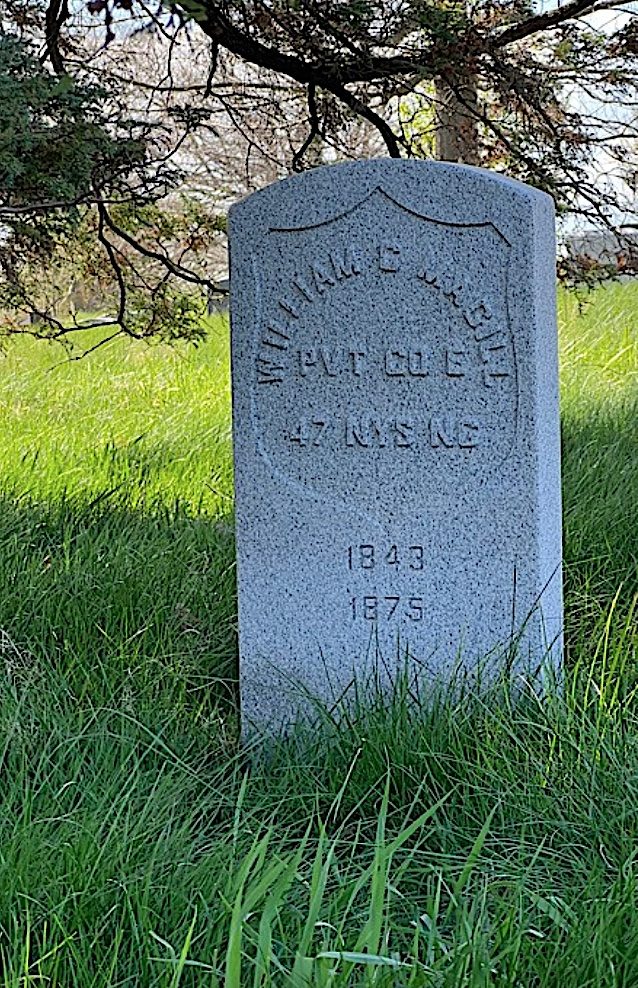
MAGNUS, THEODORE (1823-1909). Private, 7th Regiment, New York State National Guard, Company D. Magnus, who was originally from England, enlisted as a private at New York City in April, 1861. There are no further details about his service that year. In 1862, he served for three months with the 7th Regiment. He last lived at 675 Vanderbilt Street in Brooklyn. Section 12, lot 8478.
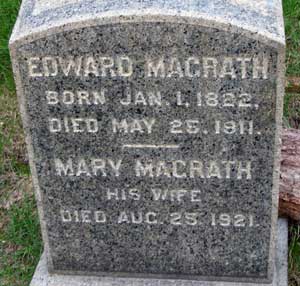
MAGRATH, EDWARD (1822-1911). Sergeant, 12th Regiment, New York State National Guard, Company G. Magrath, a native of Dublin, Ireland, was in the furniture business at the time of the 1860 census. He was 5′ 10½” tall with hazel eyes, dark hair and a dark complexion. During the Civil War, he served for 30 days with the 12th Regiment in 1863. His father, Henry Macgrath, was captain of the company according to a letter written by Edward’s brother, Henry Jr., who attested that Edward contracted rheumatism during their encampment when their tents didn’t protect them from the wet weather.
As per the 1870 census, Magrath was a wood carver; the 1880 census reports that he was a gas inspector. The Veterans Schedule of 1890 confirms his Civil War service. He applied for an invalid pension in 1899, application 1,233,564, but it was not certified. In 1904, he wrote a letter asking about his pension, indicating that he was 81, in poor health, and noted that he left his business to serve during the Civil War, lost his only son at Mobile Bay, Alabama, under General Farragut, when his ship was torpedoed, and served in the New York State Militia for seven years. He wrote, “It seems too bad that at this time of my life I must beg so long for what is right that I should have.” In 1902, he applied for and received a survivor’s pension of $12 per month as the father of Edward Jr., who served as a coal heaver on the USS Tecumseh in the United States Navy during the Civil War, certificate 16,190. In 1907, he was informed that he was not entitled to a pension increase as a survivor and was not entitled to a pension for his Army service because he only served for 30 days, less than the 90 day requirement. His last address was 191 Lexington Avenue in Manhattan. Mary Magrath, his widow and second wife, applied for a pension shortly after his death from nephritis, application 969,239. She implored the Pension Bureau to give her consideration.
I am his aged and invalid widow. We have lived together near half a century and I beg you in God’s name to grant me his pension for the short time that I may be spared here. We have no children or near relatives and my health is broken down completely with the care of him night and day in his enfeebled condition for many years. A large man that needed lifting and moving continually as he could not ly (sic) down for fear of suffocation, his doctor would tell you that I have been injured permanently by the lifting and am not fit for any labor. Hoping that you will mercifully grant this widow this request in my behalf that my age and condition calls for.
She was denied Edward Jr.’s pension because she was the step-mother and a widow’s pension because her husband’s length of service was too short. Section 35, lot 5107.
MAGRATH (or McGRATH), JOHN J. (1839-1926). Private, 4th Independent Battery, New York Light Artillery; 1st New York Engineers, Company L. Born in Baltimore, Maryland, Magrath was a stone mason living in New York City as per the 1860 census. During the Civil War, he enlisted as a private at New York City on September 16, 1861, and mustered into the 4th Independent Battery, New York Light Artillery on October 16. On December 12, 1863, he was transferred into Company L of the 1st New York Engineers, and mustered out on September 15, 1864, at Bermuda Hundred, Virginia. The 1870 census indicates that he was a brick mason; the 1880 census lists him as a plasterer. In 1899, his application for an invalid pension was approved, certificate 984,958. According to the 1900 census, he was a brick layer. He last lived at 50 Lincoln Place in Plainfield, New Jersey. Pneumonia was the cause of his death. Section 66, lot 7317.
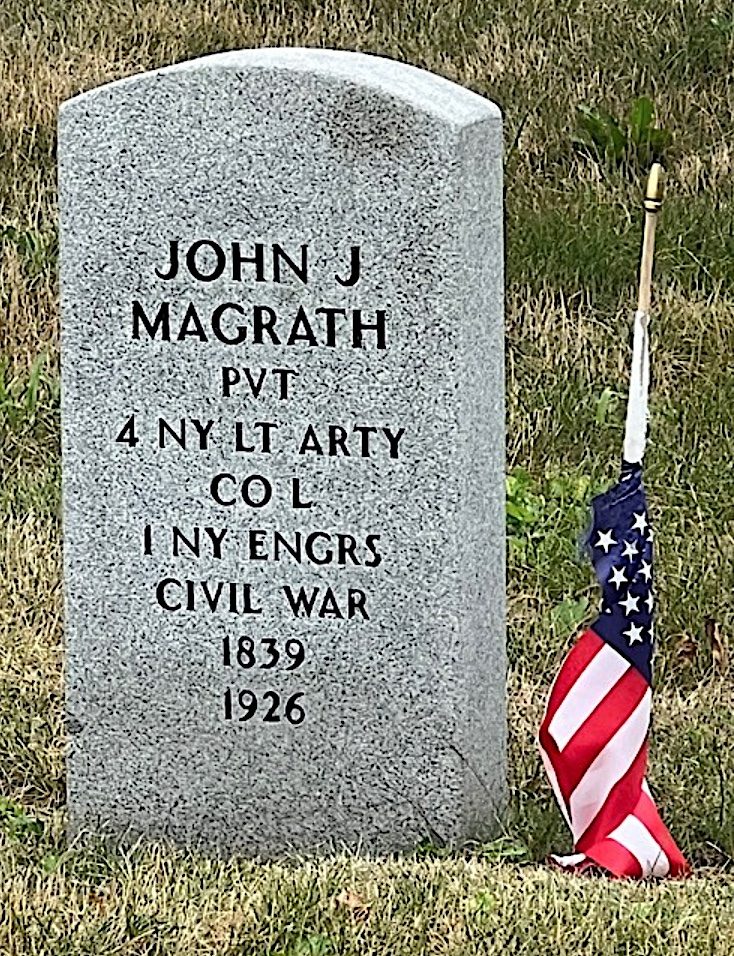
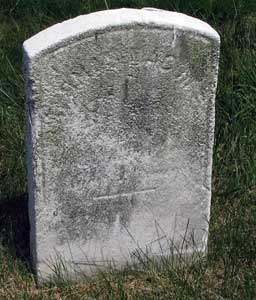
MAGUIRE, THOMAS (1842-1890). Private, 139th New York Infantry, Company I; 159th New York Infantry, Company K. Born in New York City, Maguire enlisted as a private at Brooklyn on August 28, 1862, and mustered into the 139th New York on September 9. On September 18, 1862, he transferred into the 159th New York and was discharged for disability on January 11, 1863. His application for an invalid pension was granted in 1887, certificate 385,441. The Brooklyn Directories for 1885 and 1889 list Maguire as being in the fruit business. He last resided at 86 Putnam Avenue in Brooklyn. His death was attributed to phthisis. Katie Maguire, his widow, received a pension in 1890, certificate 273,095. In 1891, a minor’s pension was granted under certificate 391,742. Section 145, lot 24096.

MAHER (or MAHAR), DANIEL H. (1842-1895). Captain 63rd New York Infantry, Companies F and D. A native of Albany, New York, Maher enlisted there as a private on March 31, 1862, and mustered into Company F of the 63rd New York three days later. As per his muster roll, he was also borne on the rolls as Daniel Mahar. He was a clerk who was 5′ 6″ tall with hazel eyes, brown hair and a fair complexion. In an undated letter, his father, Patrick Maher, wrote of the bitter battles that were endured by Company F (Daniel’s company). One excerpt included these words, “…We lost fifteen men yesterday out of Co. F, four killed and eleven wounded, and we are losing more or less every day in killed and wounded. On the morning of the 4th, my son Dan, who, you know is commissary sergeant, issued 350 rations, and on the 16th he issued only 158; so you may estimate by that how much our brigade and the Iron Second Army Corps have lost….” He was promoted to commissary sergeant on March 1, 1863, to first lieutenant in January 1865, and to captain on June 1, 1865. He mustered out on June 30, 1865, at Alexandria, Virginia.
In civilian life, Maher was a clerk at the Department of City Works. In 1891, he applied for an invalid pension that was granted under certificate 760,587. His obituary in the New York Herald, which confirms his Civil War service, states that was a member of the Moses F. O’Dell Post#443 of the G.A.R.; his obituary in the Brooklyn Daily Eagle states that comrades from his G.A.R. Post were invited to attend his funeral. His last residence was 652 Marcy Avenue, Brooklyn. His death was caused by a cerebral hemorrhage. In 1896, his child received a minor’s pension, certificate 434,973. Section 81, lot 2216.
MAHONEY, CORNELIUS J. (1842-1908). Private, 84th New York (14th Brooklyn) Infantry, Company G. A New York native, Mahoney was a sail-maker prior to his military service. After enlisting at Brooklyn on April 25, 1861, he mustered into the 14th Brooklyn on May 23. His muster roll notes that he deserted from the hospital on October 22, 1862, and was absent without leave until August 15, 1863, when he returned voluntarily. He mustered out on June 6, 1864, at New York City.
The 1886 and 1890 New York City Directories list him as a detective. Several newspaper articles reported on Mahoney’s work as a detective. One, in the Brooklyn Standard Union, stated that Mahoney was employed by the Mechanics Bank and ferreted out an alleged swindle involving two men from fine families, one of whom was employed at the aforementioned bank. In an undated article in the Brooklyn Daily Eagle, it was reported that Mahoney, while a detective, slipped and fell on ice, landing on a fruit stand and hitting his head on a coconut. While he recovered, fellow detectives brought him such treats as calf’s foot jelly and canvasback duck.
A piece on February 12, 1888, in the Brooklyn Daily Eagle, noted that Mahoney attracted attention at a ball not with his dress or good looks but because he was carrying three large diamonds in his chest pocket that were large enough to pay the ransom of European royalty. On November 20, 1888, Mahoney recalled in the New York Herald his connections to the recently arrested “Jack the Ripper.” Mahoney remembered the man as a herb doctor who was always fashionably dressed in a hunting coat decorated with gold braid at his establishment on Washington Street near Fulton Street. Known as Dr. Blackburn, he was visited often by fashionable ladies. Mahoney also recalled seeing Blackburn during the Civil War in Washington, D.C. and Virginia and then in Brooklyn, always notable for his attire.
Another report, in the Brooklyn Daily Eagle on March 18, 1894, asked Mahoney to clear up his name and honor when it was reported that an artillery man of his name and physical description deserted in Ohio. In fact, two years earlier, the charge of desertion on his soldier records was overturned and marked as “erroneous.” Mahoney remained active in military affairs. On October 28, 1879, he mustered into Mansfield Post #35 of the G.A.R. As per an article in the Brooklyn Daily Eagle on December 15, 1889, he belonged to the Moses F. Odell Post #443 of the G.A.R. and was elected as an alternate delegate to the State Encampment. In 1890, his application for an invalid pension was approved under certificate 598,878 at the rate of $6 per month. He indicated in his application that he had contracted varicose veins in his right leg between the ankle and knee caused by excessive marching during General Pope’s campaign of 1862. At the time of his pension application, he was 5′ 8¾” tall with brown eyes, brown hair and a light complexion. In 1895, Mahoney’s pension was increased to $6 because of varicose veins in right leg and loss of right foot; in 1900 his pension was increased to $10 because his disabilities were permanent.
Mahoney’s medical history was recorded as of December 5, 1899, when he was admitted to Brooklyn’s Methodist Episcopal Hospital after he was knocked out of his carriage by a trolley car. His leg was amputated four inches above his ankle. Records indicate that he was hospitalized for 60 days, getting out of bed on the ninth day of his hospitalization. The gangrenous line on his right leg was marked, the diseased skin sloughed off at gangrenous points periodically, and the affected area sprinkled with naphthalene powder daily. The pathologist reported that in addition to the amputation of his foot, Mahoney’s fibula was crushed, his tibia fractured, and the soft part of his leg infiltrated with foreign matter.
An article in the Brooklyn Daily Eagle on May 7, 1903, indicates that “Colonel” Cornelius Mahoney led a delegation of 14th Regiment Veterans at Captain Eason’s funeral. In 1904, the Brooklyn Directory reports that he had a National Detective Agency at 567 Fulton Street. A marker next to his tombstone affirms his membership in Ulysses S. Grant Post #327 of the G.A.R. As per his obituary in the Brooklyn Standard Union, which confirms his Civil War service, he was a police detective with the Brooklyn Police Department who was forced to retire after an accident led to the amputation of his leg. Mahoney’s last residence was at 296 Sackett Street in Brooklyn. His death was caused by nephritis. Josephine de Garay Mahoney, his second wife, applied for an “accrued” pension in 1908 but there is no evidence that it was certified. Section 204, lot 30043.
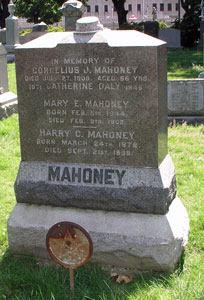
MAHONEY, DENNIS (1837-1897). Private, 5th New York Heavy Artillery, Companies A and F. Originally from Ireland, he enlisted as a private on December 30, 1863, at Brooklyn, and mustered into Company A of the 5th New York Heavy Artillery on the same date. He was transferred within his regiment to Company F on June 1, 1865, and mustered out at Harpers Ferry, West Virginia, on July 19, 1865. His pension record indicates additional service in Company E of the 5th United States Infantry. In 1878, he applied for and received an invalid pension, certificate 164,670. On November 7, 1882, he mustered into John Sedgwick Post #186 of the G.A.R. As per the G.A.R. sketchbook, he was a shoemaker. His last residence was at 259 17th Street in Brooklyn. He died of pneumonia. Section 3, lot 21025.
MAIGNE (or MOIGNE, MARGUE), JOSEPH C. (1844-1918). Private, 13th Regiment, New York State Militia, Company F. A New York City native, Maigne enlisted at Brooklyn on May 26, 1862, mustered into Company F of the 13th Regiment, and mustered out with his company at Brooklyn on September 12, 1862. As per the June 1863 Draft Registration, he lived in Brooklyn, was single, and worked as a clerk. The 1880 census indicated that he was married with two young children, lived in Brooklyn and worked as a jewelry manufacturer. In 1908, his application for a pension was approved, certificate 1,146,010. The 1910 census reports that he lived at 568 Putnam Avenue in Brooklyn, had been married thirty-two years, was able to read and write, and was a manufacturer of printing rollers. He last lived at 1112 Dean Street in Brooklyn. His death was attributed to acute cardiac dilation and chronic nephritis. Shortly after his death in 1918, Irene Maigne applied for and received a widow’s pension, certificate 862,689. Section 84, lot 8916.
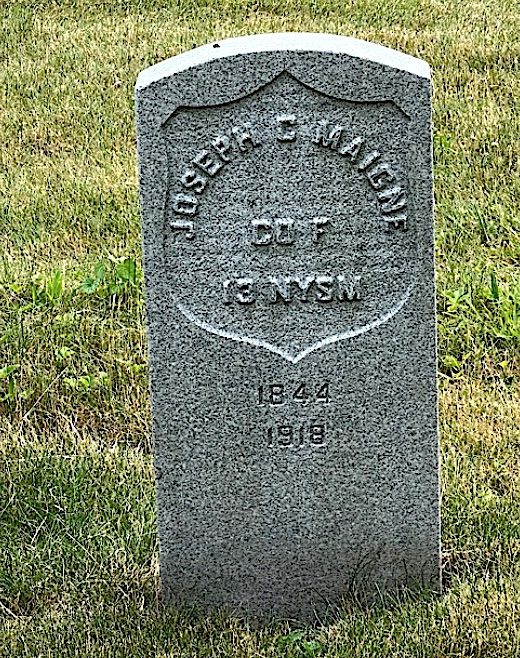
MAINE, WILLIAM A. (1832-1886). Acting master, United States Navy. Born in Plymouth, England, he ran away from home at age 12 and came to the United States as a cabin boy. After sailing the world on merchant vessels, Maine was appointed an acting master in the United States Navy on February 27, 1862, and assigned to the Brooklyn Navy Yard before he was ordered to the gunboat Aroostook as of March 29. He took part in the bombardment of Fort Darling, Virginia, at Drewry’s Bluff on May 15, 1862, during the James River campaign under Admiral Farragut, and was active in the blockade of Galveston, Texas. In 1864, he commanded the Jasmine to protect mail steamers between New Orleans, Louisiana, and Pensacola, Florida. In the summer of 1864, he applied to the Secretary of the Navy to be transferred to one of the ships involved in the capture of Mobile Bay, Alabama. He was then ordered to the sloop-of-war Seminole as acting master entering Mobile Bay on August 4, 1864. On April 8, 1865, he was detached and ordered North on the receiving ship Vermont as of July 21.
When Maine returned to New York, he was very sick. According to his wife’s pension affidavit, he contracted a severe cold while stationed in New York that later led to rheumatism of the back and finally caused Bright’s disease. Phebe Maine attested that he was taken by ambulance to her residence near the Brooklyn Navy Yard on Sands Street where he was confined to bed complaining of rheumatism of the back. After his health improved, Maine was detached on September 21, 1865, then granted a leave of absence prior to his honorable discharge on January 21, 1866.
After the Civil War, he returned to merchant ships as a sea captain. His wife reported that he took sick in the summer of 1875 at which time he requested a transfer to the U.S. Marine Hospital at Chelsea, Massachusetts, but was ultimately forced to abandon his vocation in 1884 because of back pain. Once he returned to Brooklyn, he had a ship provisions business on South Street. Mrs. Maine also had letters of praise from her husband’s superiors and a recommendation for the Civil Service. He is listed as a ship chandler in the 1886 New York City Directory, although his wife stated that he was confined to his home and unable to do more than light work as of 1885; his death certificate notes that he was a sea captain and his death was due to nephritis. As per his obituary in the New York Herald, he belonged to Cushing Post #231 of the G.A.R.; comrades were invited to attend his funeral. He last resided at 166 11th Street, Brooklyn. Phebe Maine, who is interred with him, applied for and received a widow’s pension from the U.S. Navy in 1889, certificate 6,467. Section 203, lot 25534.
MAJOR, EDMUND (or EDWIN) C. (1843-1874). Musician, 55th New York Infantry, Company B; 38th New York Infantry, Company K; private, 40th New York Infantry, Companies H and E. A New York native, the 1860 census indicates that he was a clerk. After Major enlisted at New York City as a private on November 4, 1861, he mustered into 55th New York Infantry, Company B, the same day. He was promoted to musician on August 15, 1862, and transferred to Company K of the 38th New York on December 21, 1862. On June 3, 1863, he transferred as a private into the 40th New York where he served in Companies H and E. As per his obituary in the New York Herald, he was a member of Sumner Post #24 of the G.A.R.; comrades were invited to attend his funeral following his death from pneumonia. He last resided at the home of his sister at 173 Lafayette Street in Brooklyn. Section 27, lot 8768, grave 6.
MAJOR, GEORGE (1845-1919). Private, 102nd Regiment, New York State National Guard, Company I. A New York native, Major served for 100 days in the 102nd New York State National Guard from August 6 to November 13, 1864. As per the New York City Directories for 1876, 1878, and 1888, he was employed as a clerk. The 1880 census reports that he was a clerk in a liquor store. As per the New York City Directories for 1889 and 1897 and the 1900 census, he was a bartender. Major’s Civil War service is confirmed by the Veterans Census of 1890. In 1906, he applied for and received a pension, certificate 1,129,569. The 1910 census and the 1916 New York City Directory report that he was a janitor. He last lived at 142 Christopher Street in Manhattan. He died from cancer. Frances Major, who is interred with him, applied for and received a widow’s pension in 1919, certificate 879,043. Section 196, lot 27468, grave 2.
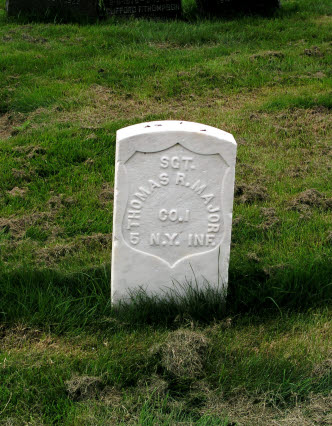
MAJOR, THOMAS R. (1839-1915). Sergeant, 5th New York Infantry, Company I. A native of Ireland and employed as a photographer at the start of the War, Major was 5′ 8½” with blue eyes and brown hair. He enlisted on April 25, 1861, at New York City, and mustered in on May 9. After promotions to corporal on November 1, 1861, and sergeant on February 1, 1862, he was wounded in the jaw and face at Gaines’ Mill, Virginia, on June 27, 1862. He was captured at Savage Station, Virginia, the next day, and paroled a month later on July 25. The injuries resulted in deafness in his left ear and loss of sight in his left eye. On September 12, 1862, he was discharged for disability at Philadelphia, Pennsylvania. His application for an invalid pension was approved on October 6, 1862, certificate 94,407.
The New York Evening Express reported in 1866 that Major was appointed as a night inspector at the United States Custom House and compensated at $2.50 per day. The 1870 census indicates that he was still an inspector at the Custom House. The 1880 and 1900 censuses state that he was a jeweler; however, the 1910 census indicates that he was again employed at the Custom House.
On March 11, 1892, an extensive feature article on Thomas Major appeared in the Brooklyn Daily Eagle. That piece, which noted that Major had at one time been a prosperous diamond broker who owned race horses, described him as a character who had a unique way with words. Apparently, Major had throat troubles and went to a German “professor’ who declared that Major was suffering from throat cancer and had to have the tumor removed. Major reported in detail about the procedure, the professor’s “yahoo” assistants, and the connection between his neck pain and war injury. The article concluded by noting that Major was recovering. Using colorful language he said, “They’ll not be makin’ any bone ornaments for their bloodwahs out of the skellington of Thomas R. Major, Brooklyn, N.Y., unless they sandbag or blackjack me.” As per his obituary in the Brooklyn Standard Union, which confirms his Civil War service, he was last employed as an inspector for the United States Custom House. He last lived at 392 15th Street in Brooklyn. Shortly after his death from nephritis in 1915, Cornelia Major, who is interred with him, applied for and received a widow’s pension, certificate 793,285. His headstone was found buried in the earth at his gravesite in 2003; it was then unearthed, cleaned, and re-installed. Section 17, lot 14888 grave 738.
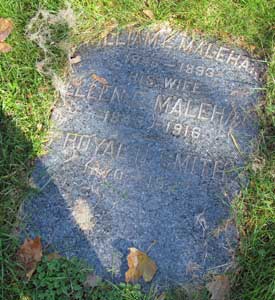
MALEHAM, WILLIAM E. (1845-1893). Private, 5th New Hampshire Infantry, Company H. A resident of Wolfeborough, New Hampshire, Maleham enlisted as a private on August 24, 1861, and mustered into the 5th New Hampshire on October 19. He was discharged for disability on January 7, 1863, at Washington D.C. The 1870 census reports that he was a carver; the 1880 census indicates that he worked in a restaurant. In 1889, his application for an invalid pension was granted, certificate 837,209. As per his obituary in the New York Herald, he was a member of the Reno Lodge. He last lived at 405 Lexington Avenue in Manhattan. Death was caused by nephritis. Ellen Maleham, who is interred with him, applied for and received a widow’s pension in 1893, certificate 376,377. Section 135, lot 27263, grave 2041.
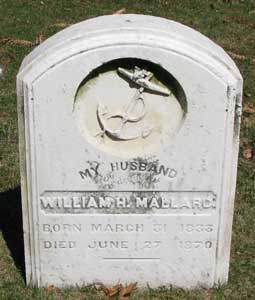
MALLARD, WILLIAM H. (1833-1870). Acting master, United States Navy. Mallard, who was born in Cambridge, Massachusetts, grew up in Brewster, Massachusetts. He was 5′ tall, went to sea when he was about 15, and was listed in the Chelsea, Massachusetts, city census of 1860 as a master mariner. He was appointed acting master in the United States Navy on January 21, 1862, with recommendations from ship owners and Massachusetts Senator Sumner. His first command was the gunboat Sebago, which was built in Portsmouth, New Hampshire, and had a crew of 100 officers and men. He served on the Sebago in the Peninsula Campaign in Virginia at City Point and on the James River. A letter in the summer of 1862 listed Mallard as a casualty of the War but that was incorrect.
In 1864, Mallard’s vessel became part of the West Gulf Squadron, and engaged in the Battle of Mobile Bay, Alabama, but he was not present. He had been being confined at the Pensacola Navy Hospital with chronic rheumatism in 1864, returned to Brooklyn to restore his health and then returned to duty later that year on the supply steamer Fort Morgan. In February of 1865, Mallard was transferred to the USS Daffodil, a side-wheel ship that was part of the South Atlantic Squadron, and received a citation for action on the Edisto River, South Carolina. The citation read, “The Daffodil came under enemy fire from batteries while dragging the Edisto River for torpedoes. Acting Master Mallard rendered valuable services and used her guns to suppress Confederate batteries.” He also served on the USS Ino, a clipper ship. He was honorably discharged on May 27, 1867. Appointed to the Brooklyn Navy Yard in 1867, he served there until his death from myelitis. His last residence was 60 Prince Street in Brooklyn. Section 106, lot 10730.
MALLETT (or MALLETTE, MALETT, MALETTE), DANIEL HERBERT (1840-1899). Private second class, United States Signal Corps; private, 2nd New York State Militia (later known as the 82nd New York Infantry), Company A. Mallett was born in England and immigrated to New York with his parents and three sisters from London and Portsmouth aboard the Westminster when he was eight months old. The census of 1860 reports that he lived in Castleton, Staten Island, with his parents and younger brother, and was employed as a painter.
On September 1, 1861, he enlisted as a private at New York City and mustered into Company A of the 82nd New York Infantry. He was captured at White Oak, Virginia, on July 1, 1862, and confined at a Richmond prison until his parole the next month on August 6. He was transferred into the United States Signal Corps on October 6, 1863, from which he was discharged on September 1, 1864. Two months prior to his discharge, his father, Joshua Mallett, took his own life by hanging. His younger brother, Markham, also served in the Civil War in Company I of the 156th New York Infantry.
The Brooklyn Directory lists Mallett as a paperhanger and the 1869, 1870 and 1871 Brooklyn Directories identify him as a painter. According to the 1875 New York State census, he and his family were boarders living in Brooklyn. At the time of the 1880 census, he lived at 305 23rd Street in Brooklyn with his wife and two young children and was still working as a painter. The Brooklyn Directories for 1881 and 1883 note that he was a painter still living at the 23rd Street address. In the 1890 Brooklyn Directory, he was listed as a decorator and his wife as a dressmaker; they lived at 54 Willoughby Avenue.
In 1890, he applied for and received an invalid pension, certificate 606,144; his pension index card reports his name as Daniel Mallette. The 1897 Brooklyn Directory identifies him as a painter living at 28 Spencer Place. As per his death certificate, which also uses the spelling of Mallette (as does the Green-Wood Cemeterydatabase), he was married and employed as a painter. He last lived at 28 Spencer Place in Brooklyn. His obituary in the Brooklyn Daily Eagle and his death certificate attribute his death to heart failure. Jennie Mallett applied for and received a widow’s pension in 1900, certificate 490,337. Records from the Adjutant General’s Office in 1891 note that he was discharged as a second class private at the expiration of his service. Greg DiSalvio, a Brooklynite, takes the persona of Mallett in Civil War reenactments and has collected many documents and artifacts related to his service. Section 205, lot 30362, grave 1.
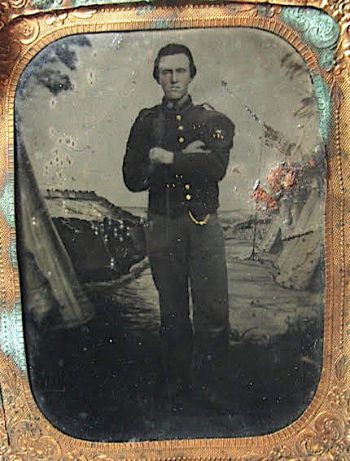
MALONE, FRANK (1848-1925). Bugler, 2nd New Jersey Cavalry, Company A. Malone, a native of England, enlisted as a bugler on August 3, 1863, and mustered into the 2nd New Jersey Cavalry eight days later. He was wounded at the Battle of Bolivar, Tennessee, on May 2, 1864. This report on that action was written by Major P. Jones Yorke, commanding the 2nd New Jersey and sent to General Robert F. Stockton, adjutant general of New Jersey:
GENERAL: I have the honor to report that on the 30th of April a force under the command of Brigadier-General Sturgis left Memphis in pursuit of General Forrest.
On the 2nd of May we reached Somerville, Tenn., and halted. It being ascertained that a force of the enemy held the town of Bolivar, on the Hatchie River, a distance of 23 miles from Somerville, Colonel Kargé, commanding the First Cavalry Brigade, was sent forward with a force consisting of 200 of the Tenth Missouri Cavalry, 400 of the Second New Jersey Cavalry, and a section of guns belonging to the Tenth Missouri Cavalry. Starting at 1:30 p.m., we made a forced and very rapid march, and found the enemy, 800 strong, under command of Major-General Forrest, in position behind strong intrenchments and fortifications, about 1 mile from Bolivar. After a severe engagement of two hours’ duration we routed the enemy and drove them from their intrenchments and through the town, and but for the lateness of the hour (it being after 8 p.m.) and our utter ignorance of the country through which the enemy retreated, would have captured or destroyed the entire force.
The loss of our regiment in this action was 2 killed, 5 wounded, and 20 horses killed and wounded….
I am happy to say that the Second New Jersey Cavalry enjoys the best reputation, and the esteem not only of the commanding general, but all the troops on this department….
After being wounded, Malone was moved to the Ward U.S. General Hospital in Newark, New Jersey, and mustered out on June 11, 1865, at Newark. His application for an invalid pension was approved in 1866, certificate 65,808. The Brooklyn Directory of 1873 notes that Malone was a plumber; the 1878 Brooklyn Directory of 1878 lists him as a laborer and the 1882 Brooklyn Directory reports that he was a foreman. He died of broncho pneumonia at the Home for Disabled Soldiers in Kearny, New Jersey. Section 206, lot 31425, grave 2.
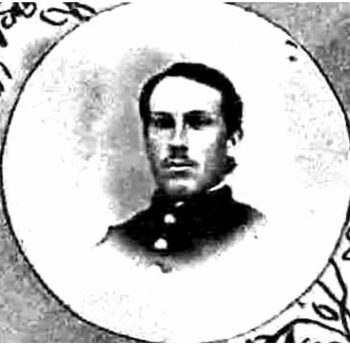
MAN, FREDERICK HALSEY (1843-1928). Major by brevet; captain, 7th Louisiana Colored Troops; 79th United States Colored Troops (USCT), Company I; 84th United States Colored Troops (USCT), Company A; corporal, 22nd Regiment, New York State National Guard, Company H. A New York City native, Man graduated from City College in 1861 and entered Columbia Law School. During the Civil War, he interrupted his studies and enlisted as a corporal on May 28, 1862, mustered into the 22nd Regiment, and mustered out with his company on September 2, 1862, at New York City. On May 18, 1863, he wrote to his father from Brashear City, Louisiana, where he was a captain with the 7th Louisiana Colored Troops. Man told his father that he was in charge of 30 colored men who “learn easily” and whom he hoped to make good soldiers. Man referred to the men, who came in caravans from the bayou, as “contraband” and noted that many begged to enlist but that they were subject to strict physical examination. He also asked his father to send him some good brandy and currant wine; he noted that his health was good in spite of the unhealthy water they were forced to drink when there was no rain water collected in above-ground cisterns. After being promoted to captain on August 31, 1863, he was commissioned into Company I of the 79th United States Colored Troops (USCT) that same day. He mustered out on July 28, 1864, the same day that he was transferred to Company A of the 84th USCT. Man was promoted to major by brevet “for faithful and meritorious service” on March 13, 1865, and mustered out on June 22, 1865.
As per his obituary in The New York Times, which confirms his Civil War service, Man returned to his legal studies after his military duty ended and was an 1865 graduate of Columbia Law School. He mustered into the John Adams Dix Post#135 of the G.A.R. on May 11, 1881; as per the post’s sketchbook, he was living in Manhattan and working as a lawyer. In 1907, he applied for and received a pension, certificate 1,141,124. His obituary in The New York Times indicates that he was a member of the New York State Bar for 60 years and last practiced with the firm of Man & Man at 67 Wall Street. He was the brother of William Man (see). At the time of his death, he was a widower. He last lived at 30 West 7oth Street in Manhattan. His death was attributed to pneumonia. Section 182, lot 19322.
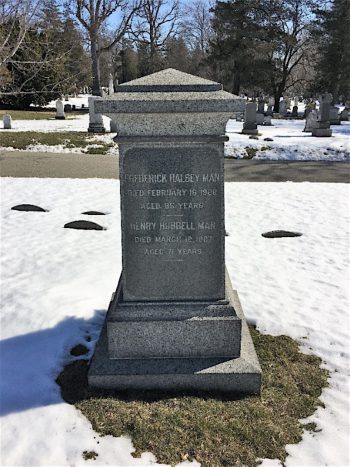
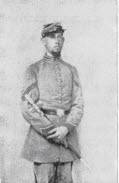
MAN, WILLIAM (1839-1906). Second lieutenant, 22nd Regiment, New York State National Guard, Company H. A New Yorker by birth, he was educated in the public schools and graduated from the Free Academy which later became the College of the City of New York. After studying law at Harvard, he was admitted to the bar in New York in 1861. He enlisted at New York City as a sergeant on May 28, 1862, and mustered into the 22nd National Guard that day. He was soon promoted to second lieutenant on July 21, 1862, and mustered out on September 5. His service continued when he was commissioned into the same regiment and company for an additional 30 days on June 18, 1863. According to his obituary in The New York Times, his regiment fought at Harpers Ferry, (now West Virginia), and Gettysburg, Pennsylvania.
A lawyer with the firm of Man & Man, he practiced on Wall Street. Among the numerous organizations that he belonged to were the Union League Club, the Metropolitan Club and the New-York Historical Society. He was the brother of Frederick H. Man (see). His last address in New York City was 69 West 10th Street. Man’s death was caused by arteriosclerosis. Celestine Man applied for a widow’s pension, application 1,198,164, but there is no record of it being certified. Section 182, lot 19322.
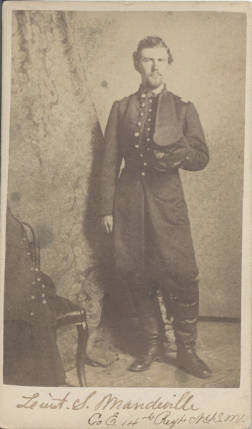
MANDEVILLE (or MANDERVILLE), STEPHEN (1838-1869). Captain, 84th New York (14th Brooklyn) Infantry, Companies E and G. A New Jersey native, Mandeville was living there in Woodbridge according to the 1850 census. The 1860 census states that he was a farmer in Groton, Connecticut. During the Civil War, he enlisted as a sergeant at Brooklyn on April 18, 1861, and mustered into Company E of the 14th the next month on May 23. During his military service, he rose to second lieutenant on August 4, 1861, to first lieutenant on February 23, 1862, although he did not muster in at that rank, and to captain on October 10, 1863, effective upon his transfer to Company G on November 24, 1863. He mustered out at New York City on June 6, 1864. Phthisis (tuberculosis) claimed his life in Rahway, New Jersey. Section 43, lot 558.
MANESCO (or MANESCA), LOUIS (or LEWIS) (1815-1880). Corporal, 84th New York (14th Brooklyn) Infantry, Company D. Born in Brooklyn, he enlisted as a private on April 18, 1861, at Brooklyn, mustered into the 14th on May 23, was promoted to corporal on November 1, 1862, and mustered out at New York City on June 6, 1864. According to his obituary in the Brooklyn Daily Eagle, his father, John Manesco, who was from Santo Domingo, was a prominent teacher who wrote The True Method of Teaching Living Languages. Louis Manesco was a noted French scholar and had great knowledge about the old families of New York and Brooklyn. Manesco’s last residence was 287 Gates Avenue in Brooklyn. He died of pneumonia. Section 1, lot 8265.
MANG, FREDERICK GEORGE (1831-1889). Private, 98th Pennsylvania Infantry, Company K. Originally from Bavaria, Germany, Mang, a resident of Philadelphia, enlisted as a private on September 9, 1861, and mustered into the 98th Pennsylvania the same day. The 98th Pennsylvania, composed mainly of German soldiers, was sent to guard Washington, D.C., at Tennallytown. On March 10, 1862, he 98th joined the Peninsula Campaign and fought at the Battles of Williamsburg and Malvern Hill, Virginia. In the spring of 1863, the 98th was sent to Chancellorsville, Virginia. Malone deserted on May 1, 1863.
According to the census of 1870, Mang was a marble cutter whose real estate was valued at $2,500, and whose personal estate was $100. The Brooklyn Directory of 1872 indicates that he was a stone cutter while the 1881 Brooklyn Directory lists him in the liquor business. An article in the Brooklyn Union on May 14, 1884, reports that he and his wife Clara were arrested for selling liquor on a Sunday. He returned to the stonecutting business in 1885 according to the listing in the Brooklyn Directory. His last residence was located on 92nd Street and 4th Avenue in Brooklyn. He died of valvular disease of the heart. Section 137, lot 29120, grave 2.
MANGAM, FRANKLIN (1842-1876). Musician (unit and company unknown); private, 7th Regiment, New York State National Guard, Company C. A native of New York City, Mangam was living in Poughkeepsie, New York, at the time of the 1860 census. His passport application of 1864 indicates that he was 5′ 8¾” tall with light blue eyes, auburn hair, light complexion, prominent nose, round and full face and round chin. He enlisted on May 25, 1861, as a musician, but there are no other details of that enrollment. In 1862, he served with the 7th Regiment when it was called to duty for three months. He returned to the same company when the 7th was reactivated in 1863 for 30 days. As per the New York City Directory of 1868, he was a banker (like his father, Darius Mangam); the 1872 New York City Directory reports that he was in the piano business. His last residence was 126 West 63rd Street in Manhattan. Pneumonia was the cause of his death. Section 83, lot 1536.

MANGELS, CLAUS (1833-1888). Captain, 5th Regiment, New York State Militia, Company A. Born in Hanover, Germany, Mangels became a naturalized citizen in 1856. According to the physical description on his passport application in 1859, he was 5′ 8″ tall with greenish hazel eyes, brown hair, a florid complexion, high forehead, full oval face and round chin. During the Civil War, he enlisted as a corporal on April 19, 1861, at New York City, mustered into the 5th New York State Militia on May 1, was promoted to first lieutenant on June 1, and mustered out at New York City on August 7. When his unit was reactivated for 30 days in 1863 and part of the 5th National Guard, he was commissioned into the same company on July 4, and was simultaneously promoted to captain. The 5th Regiment performed guard duty in the wake of the Gettysburg campaign. Mangels mustered out on July 22 at New York City.
The 1878 New York City Directory and the 1880 census report that Mangels was a grocer; his store was located at 100 Eighth Avenue in Manhattan. As per his obituary in the New York Herald, he belonged to St. Paul’s Congregation, the Royal Arcanum and the New York Retail Grocers’ Union; members were invited to attend his funeral. His last residence was on West 86th Street in Manhattan. His death was caused by nephritis. In 1892, Christine Mangels, who is interred with him, applied for and received a widow’s pension under certificate 364,468. Section 13, lot 9512.
MANGOLD, JACOB W. (1843-1892). Hospital steward, 107th Ohio Infantry, Company A. Mangold, who was born in Germany, enlisted on September 22, 1862, as a private, the same day that he mustered into the 107th Ohio’s Company A. On June 11, 1864, Mangold was promoted to hospital steward and transferred into the Field and Staff. He mustered out on July 10, 1865, at Charleston, Ohio.
According to the 1870 and 1880 censuses, he was a drugstore clerk known as William Mangold whose personal estate was worth $200 in 1870. An article in The New York Times on December 21, 1879, reports that he was elected vice commander of the Abraham Lincoln Post #13 of the G.A.R. The 1888 and 1891 New York City Directories state that he was a clerk. The 1890 Veterans Schedule confirms his Civil War service. He applied for an invalid pension in 1892, application 1,090,645, but died before it was certified. Mangold last resided at 526 East 16th Street in Manhattan. Shortly after his death from “fever” in 1892, Phillippina (Philipine) Mangold, who is interred with him, applied for and received a widow’s pension, certificate 366,748. Section 17, lot 17245, grave 919.
MANLEY, GERVASE (or GERVAISE, JERVASE) BURR (1837-1914). Private, 106th Pennsylvania Infantry, Company F. After Manley, a Philadelphia resident, enlisted as a private on August 28, 1861, he immediately mustered into the 106th Pennsylvania. He was discharged from military service on September 10, 1864. His pension record notes that he also served in the regiment’s Company A.
A man with many different occupations throughout his lifetime, the censuses of 1870 and 1880 indicate that Manley was a laborer. In 1890, his application for an invalid pension was granted, certificate 740,612. The New York State Census of 1892 and the 1900 census report that he was employed as a fish vendor. As per the 1904 New York City Directory, he was a superintendent; the 1910 census states that he was a park foreman. According to his obituary in The New York Times, which confirms his Civil War service, he had been a foreman for the Park Department in charge of Bensonhurst Park in Brooklyn. Manley was also an active member of the Bay Ridge Reformed Church. He last resided at 444 78th Street in Brooklyn. Shortly after his death from colitis in 1914, Mary Manley, who is interred with him, applied for and was awarded a widow’s pension, certificate 787,110. Section 192, lot 28831.
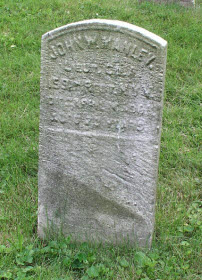
MANLEY (or MANLY), JOHN W. (1840-1863). First lieutenant, 159th New York Infantry, Companies H, D, and A; private, 13th Regiment, New York State Militia, Company B. After serving three months in the 13th State Militia in 1861, Manley re-enlisted at Brooklyn on September 2, 1862, and was commissioned into Company H of the 159th New York on October 2, the same day that he was promoted to second lieutenant and transferred to Company D. He was promoted to first lieutenant and transferred to Company A on January 27, 1863. On April 14, 1863, he was killed in action at Irish Bend, Louisiana. He was interred at Green-Wood on December 16, 1863. A government-issued gravestone, circa 1900, marks his grave. Section 67, lot 4167.
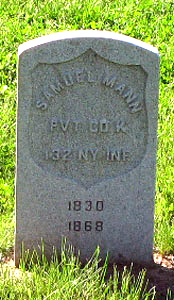
MANN, SAMUEL (1830-1868). Private, 132nd New York Infantry, Company K. Mann, who was born in New York City, enlisted as a private at Brooklyn on August 29, 1862, and mustered into the 132nd the next day. His muster roll reports that he was a piano maker who was 6′ ½” tall with black hair, brown eyes and a dark complexion. He was discharged on an unstated date. As per a news article about his death in the Albany [New York] Argus, “During the up passage of the steamer Drew on Wednesday night, one of the cooks named Samuel Mann, was taken suddenly ill and died. The deceased had been ailing for some time, but his illness did not assume a dangerous aspect until a late hour Wednesday night. Upon the arrival of the boat yesterday morning, Coroner Mulligan was notified, who summoned Dr. Lamb. It was ascertained that death was produced by hemorrhage of the lungs. The deceased was about 38 years of age, and belonged to New York, whither the remains were taken.” His last residence was in New York. Section 6, lot 9932, grave 74.
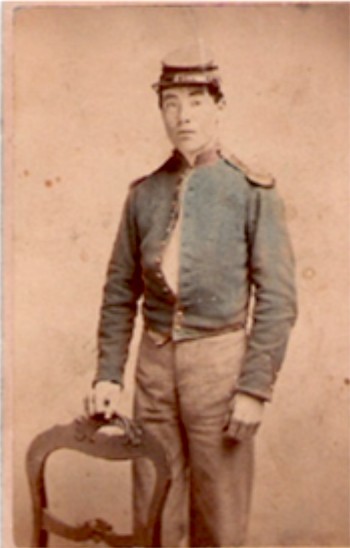
MANNING, JOHN H. (1843-1915). Sergeant, 9th Massachusetts Independent Battery Volunteers. Manning was born in Sligo, Ireland. The year of his immigration is unclear. Some records indicate that Manning immigrated to the United States with his family during the potato famine of 1848 and settled in Boston, Massachusetts. His obituary, however, states that his family immigrated when he was two-years-old (the beginning of the Great Famine). A brush-maker by trade and resident of Cambridge, Massachusetts, he was employed there at the Charlestown Navy Yard in 1860.
During the Civil War, Manning enlisted as a private on August 4, 1862, at Boston. Six days later, he mustered into the 9th Massachusetts Independent Battery (Light Artillery) at Camp Stanton in Lynnfield, Massachusetts; his muster roll notes that he was paid a bounty of $25 and owed $75.00. As per the Descriptive Book of his battery, he was 5′ 10″ tall with brown eyes, brown hair and a dark complexion. The 9th Massachusetts spent most of the winter of 1862-1863 guarding the defenses of Washington, D.C., before moving to Centreville, Virginia, where they were stationed until the Gettysburg Campaign. They had just received a new commanding officer, Captain John Bigelow, who made sure the men were better fed and more efficient in their daily routines and drill. By June 15, the regiment was on the move, and being green to marching, found it difficult.
By July 2, 1863, the second day of the Battle of Gettysburg, the men were camped near George Spangler’s farm east of the Taneytown Road and just south of Granite Schoolhouse Lane; they had time to rest, water their horses, and get fed. By 4:00 p.m., the 9th Battery found themselves engaged near the Trostle Farm at Millerstown Road (now Wheatfield Road). The sights and sounds of the fighting were unnerving to the green troops but Bigelow gave the order, “Forward into line, left oblique! Trot! Action front.” The 9th had 110 men, six twelve pound Napoleons and 88 horses as they were ordered to shell Rose’s Farm and Woods. The battery’s historian commended the regiment in greatly aiding the Union men on Stony Hill in holding that place for as long as they did. When the 9th Battery found themselves alone on the field without support, they retired by prolong (pulling the cannons to the rear with men rather than horses. They pulled back to Trostle’s Barn, firing as they went. Bigelow had his men make their final stand as they fought the 21st Mississippi, expending over three tons of shot and shell, including 92 rounds of canister. The battery was overrun; Captain Bigelow was shot twice but survived, 27 men were wounded or killed and 80 horses killed or disabled but the 9th gave Lieutenant Colonel McGilvery enough time to get his artillery into place. On August 8, 1863, Manning was promoted to corporal. In March 1864, he became a gunner and six months later he was promoted to sergeant at Weldon Railroad, Virginia. He mustered out on June 6, 1865, at Gallop’s Island in Boston Harbor; at muster-out he was due the remaining $75.00 of his bounty.
In 1868, Manning moved to Chicago, Illinois, where he was a fireman and later an engineer on a steam fire engine. After the famous Chicago fire in 1871, he moved to Cincinnati, Ohio, then lived briefly in Indiana before returning to Ohio where he owned his own steam apparatus enterprise. In 1886, he relocated to Chicago where he worked for the Crane Company, manufacturers of steam-fitting supplies. Crane transferred him to New York in 1896, as a mechanical engineering superintendent. Manning held several patents for steam-related devices. In 1905, his application for a pension was approved, certificate 1,115,574. His obituary in the Brooklyn Standard Union confirms his Civil War service. His last address was 314 Lewis Avenue in Brooklyn. Shortly after his death in 1915, Jeanette Manning, who is interred with him, applied for and received a widow’s pension, certificate 800,841. Section 131, lot 34230, grave 2.
MANNING, MARY (1815-1905). Civil War nurse. As per the MOLLUS-MASS collection of Civil War photographs, compiled by the Commandery of the Massachusetts Order of a Loyal Legion, a patriotic organization, Manning, who lived at 305 Clinton Avenue in Brooklyn, was a Civil War nurse who served in 1861 at hospitals around New York. In 1864, she served at David’s Hospital in New York Harbor. She subsequently was a visitor at the Naval School and at St. John’s College Hospital from December 1864 until April 1865. She died in Brooklyn. Section 103, lot 21041, grave 2.
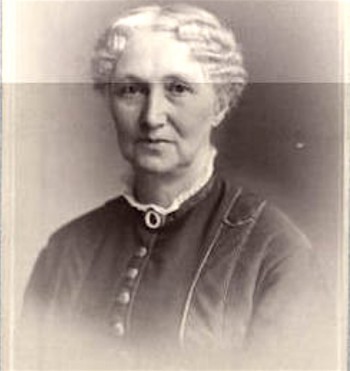
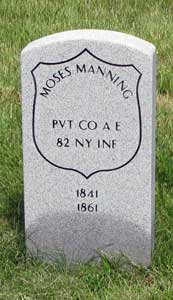
MANNING, MOSES (1841-1861). Private, 82nd New York Infantry, Companies A and E. Originally from Ireland, Manning enlisted on May 21, 1861, at New York City, and mustered into Company A of the 82nd New York that date. He was transferred to Company E on July 15, 1861, and died of intermittent fever and anasarca (generalized edema or swelling of the skin caused by organ failure) in a regimental hospital at Poolesville, Virginia, on December 11, 1861. He was interred at Green-Wood three days later. On August 4, 1864, Ellen Manning, his mother, applied for and a received a pension, certificate 158,254. Section 127, lot 8998, grave 567.
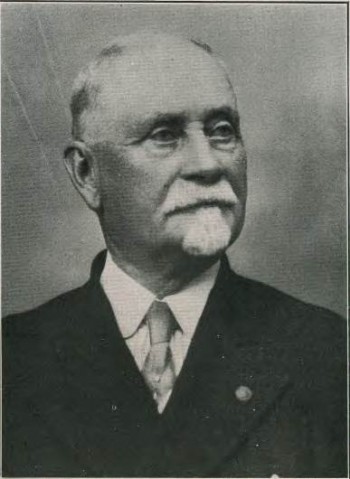
MANSON, DONALD ALEXANDER (1839-1921). Master at arms, United States Navy. Born in Thurso, Scotland, and fatherless at age three, Manson immigrated to the United States in 1851 with a brother and sister, leaving his mother behind at the family’s farm. A carpenter, he was 5′ 6″ tall with light hair, grey eyes and a fair complexion. After enlisting on June 10, 1861, he entered the United States Navy, served aboard the USS Carolina as a landsman, the war-sloop Savannah on the James River, and was then dispatched to the Atlantic Blockading Squadron on the gun-boat Madgie. He was discharged from the Minnesota at Hampton Roads, Virginia, on January 9, 1864. According to his pension records, he was a master at arms at the time of his discharge. His eldest brother, William, who was a major in the 79th Regiment, was a prisoner at Libby Prison in Richmond, Virginia, but was one of the first officers to be exchanged.
After the War, Manson opened a carpentry and cabinet-making establishment in the Wall Street area where he did business for 38 years. A vice president and appraiser at the Greenpoint Savings Bank in Brooklyn for many years, he was a member of the Greenpoint Commerce Club, the Greenpoint Taxpayers’ and Citizens’ Association, and director of the Greenpoint Y.M.C.A. Active in community and church affairs, he was a Freemason, a member of the G.A.R.’s Ulysses S. Grant Post #327 where he held the post of lieutenant commander, and belonged to the 47th Regiment Veteran Association. He received a pension of $8 a month from the Navy in 1903, certificate 35,926, that was raised to $24 a month in July 1912 and $30 a month as of August 3, 1914. Although he had eleven children, all but four sons died in infancy. He last lived at 114 Milton Street in Brooklyn. His death was caused by heart disease. Section 142, lot 22329.
MANSON, WILLIAM (1823-1880). Captain, 79th New York Infantry, Company A. According to a descendant, Manson was born on November 21, 1823 at Wolfburn farm, Thurso, Caithness, Scotland. The descendant reports that William was baptized and that she has the record of the midwife who attended his birth. His birth year is confirmed by the 1841 Scottish census which reports that a William Manson was born in Thurso in Caithness County in about 1823 and was living in that county, working as an agricultural laborer. An online posting about him on the Find A Grave website incorrectly lists his birth year as 1834.
According to his solder record, he enlisted as a captain at New York City on May 28, 1861, and was immediately commissioned into Company A of the 79th New York, also known as the Highlanders. Manson was taken as a prisoner of war on an unknown date and exchanged at Fort Monroe, Virginia, on December 31, 1861. His online biography notes that he was captured at the First Battle of Bull Run in July 1861, and imprisoned in Richmond, Virginia. He was discharged on March 29, 1862. His obituary in the Brooklyn Daily Eagle, which confirms his Civil War service and his prominence among Scotsmen in New York City, mistakenly states however that he served as a captain with the 71st Highlanders National Guard; there is no soldier record of his serving with that regiment. As per his obituary, he was a liquor dealer at 19 Beekman Street in Manhattan, a business that he ran for 32 years. His death was a suicide attributed to a “temporary aberration of mind.” Section 142, lot 11638.
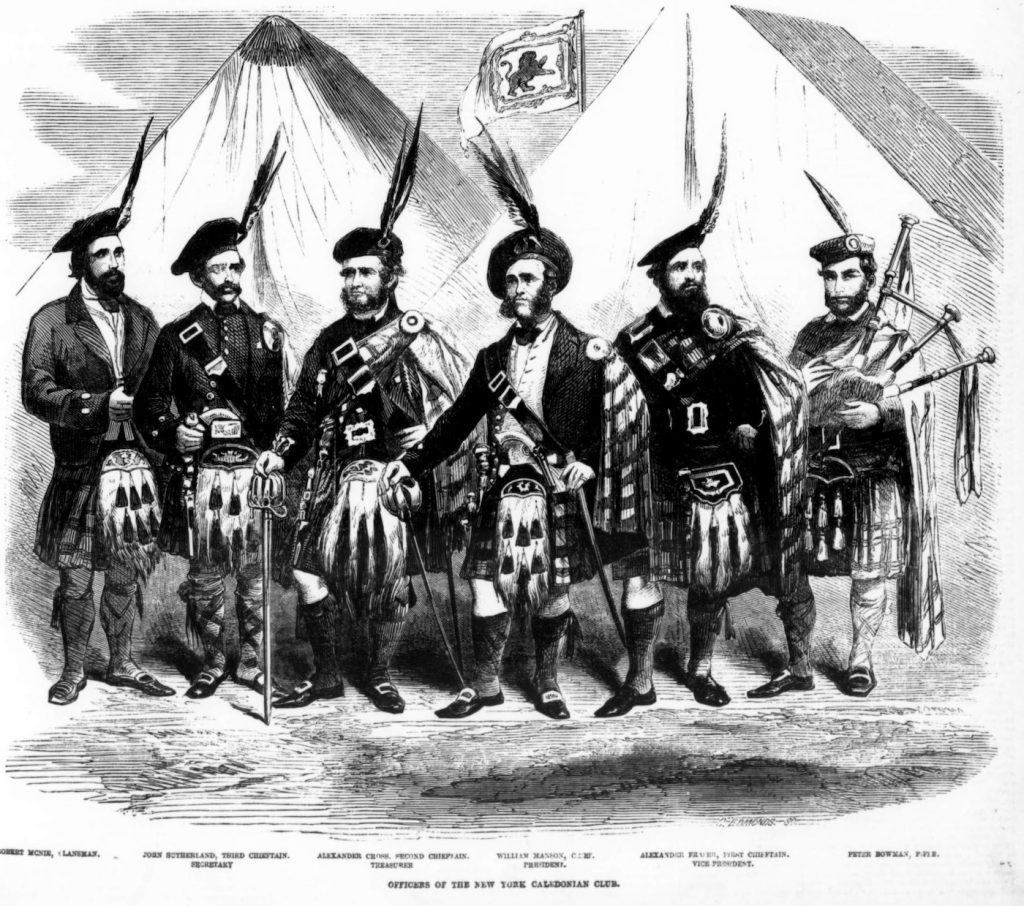
MAPLES, EDMUND (or EDWARD) (1827-1881). Private, 72nd New York Infantry, Companies G and C. Born in Nottingham, England, Maples enlisted at Camp Scott, Staten Island, as a private on July 23, 1861, mustered into Company G that day, and shortly thereafter transferred to Company C. The 72nd was first assigned to Washington, D.C., then was assigned to Sickle’s Excelsior Brigade, Hooker’s Division, and served along the Potomac in Maryland, near Stafford Court House, Virginia, before entering the Peninsula Campaign where the Excelsior Brigade suffered heavy losses at the Battle of Williamsburg, Virginia. According to the records of the U.S. Homes for Disabled Volunteer Soldiers, Maples was among the many wounded there, suffering a left inguinal hernia on May 5, 1862. He was discharged for disability on July 13, 1862, at Virginia. He applied for an invalid pension on August 30, 1862, that was granted under certificate 26,257.
Maples is listed as a plumber on the 1870 census. At the time of the 1880 census, he was living at the National Military Home in Dayton, Ohio, having been admitted on July 24, 1875. He was discharged from the Soldiers’ Home on October 22, 1880, and last lived at 358 7th Avenue, New York City. Upon his death caused by rheumatism, Grace Maples, who is interred with him, applied for and was granted a widow’s pension, certificate 198,692. Section 2, lot 5499, grave 1053.

MARALIOUS, JOHN (1825-1900). Captain, 13th Regiment, New York State Militia, Engineers. Born in Boston, Massachusetts, he enlisted as a captain on April 23, 1861, was commissioned into the Engineer Company of the 13th New York State Militia at Brooklyn on May 17, and mustered out there on August 6. Active in the Republican Party, Maralious was involved in the Starin Clubs, organizations endorsing the nomination of John Starin, a Congressman from Fultonville, New York, for governor of New York. An article in the Brooklyn Union Argus on August 14, 1879, indicates that Maralious owned an English bunting flag with Starin’s name hand-worked into the banner and offered it to the party organization to promote Starin’s nomination. The 1880 census notes that he was a clerk at the Custom House.
According to his obituary in The New York Times, which confirms his Civil War service, Maralious was an engineer for the New York Central and Hudson River Railroad and served in a similar capacity with other railroad companies in New Jersey. His death was caused by a self-inflicted pistol shot. He was apparently despondent after suffering from Bright’s disease (a kidney ailment) for more than fifteen years. News of his death appeared in obituaries in the Springfield Republican [Springfield, Massachusetts] and the Boston Herald on December 8, 1900. Those obituaries note that he served with the 13th New York signal corps. He last resided with his daughter at 757 Sterling Place in Brooklyn. Section 13, lot 7697, grave 6-7.
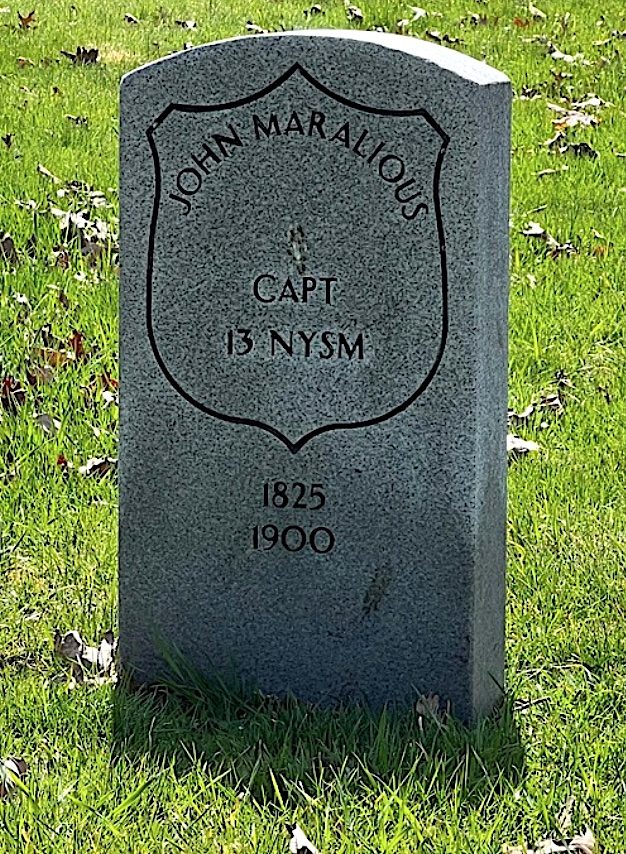
MARCELL (or MARSELL, MARSCELL), CALEB BALDWIN (1838-1910). Landsman, United States Navy. Marcell was born in Lyons Farms, New Jersey. Although his headstone records his birth year as 1837, that is incorrect, his birth record from Essex County, New Jersey, shows that he was born on December 1, 1838. As per the 1855 New York State census, he lived in Seneca, New York, with his parents and two younger sisters. The 1860 federal census shows that he lived in Livingston, New York, with his parents and sisters and worked as a clerk in a store. At the time of enlistment as a landsman in the United States Navy on August 9, 1862, he indicated that he was 24 years old, 5′ tall with blue eyes, brown hair, a fair complexion and had no previous military service. During his time in the Navy, he served aboard the USS Kearsarge. He was discharged on August 31, 1863.
Marcell relocated to Brooklyn in 1869. The 1892 New York State census reports that he was living in Brooklyn and was employed as a fruit dealer. He received a pension from the Navy, certificate 21,985. As per his obituary in the Brooklyn Standard Union, which confirms his Civil War service, he was a fruit dealer for more than 30 years and lived at 276 14th Street. He was survived by his wife, Sarah, and a son, Frank. His death in Brooklyn is recorded in the records of the Dutch Reformed Church. Section 135, lot 27263, grave 2465.
MARCHANT, EDWARD DALTON (1806-1887). Anti-slavery advocate and portrait painter of President Abraham Lincoln. Born in Edgartown, Massachusetts, Marchant studied briefly with famed portrait artist Gilbert Stuart in Boston in 1825. He took up residence as an artist in New York City in the 1830s, then settled in Philadelphia, Pennsylvania, in 1854. Marchant was well-known as a portrait and miniature painter. His son, Henry Marchant (see), was also a miniature painter who assisted him in his work.
In December 1862, Edward Marchant, an anti-slavery advocate, was commissioned by the Union League of Philadelphia to paint a portrait of President Abraham Lincoln for display there at Independence Hall. The Union League, concerned about support for the South in Philadelphia, pledged political and financial support to the Union cause. That portrait would depict Lincoln after signing the Emancipation Proclamation. Edward Marchant was given a letter of introduction to the President by John W. Forney, a well-connected Philadelphia politician and journalist. On February 27, 1863, President Lincoln wrote to Major General Joseph Hooker asking that Captain Henry Marchant of the 23rd Pennsylvania, be excused for five days to help his father with the execution of the portrait for Philadelphia. On March 5, Lincoln asked that the leave be extended for another five days. The article, Philadelphia’s Cultural Landscape: The Sartain Family Legacy, edited by Katharine Martinez, Page Talbott and Elizabeth Johns, discusses the history of that portrait and its intent to promote support for President Lincoln and the restoration of the Union. The Lincoln portrait, which was completed in May 1863, was displayed for three years at Independence Hall, then became the property of the Union League. The article notes that Marchant had hoped that the portrait would have been given as a gift to the city but that never happened. Marchant wrote of the portrait, “I have sought…to symbolize, on canvas, the great, crowning act of our distinguished President.” The essay notes that Marchant’s portrait of Lincoln was idealized and in contrast to many of the caricatures that were then in wide circulation. Further, Marchant’s support for the Emancipation Proclamation mirrored the views of the Union League but not the general populace.
In spite of the lackluster interest in Marchant’s work at Independence Hall, John Sartain, an abolitionist, published a mezzotint of Lincoln in 1864 which sold well and which prompted Marchant to create a lithograph of the President without references to the Emancipation Proclamation. Edward Marchant was an invalid for much of his later years and his wife depended upon her son Henry for support and then relied on the gifts of friends to meet their everyday expenses after Henry was killed in battle. As per his obituary in the Philadelphia Inquirer, Marchant painted portraits of several presidents of the United States that decorated the White House. Marchant’s portraits are displayed at numerous museums including the Smithsonian American Art Museum, The Metropolitan Museum of Art in New York City and the New-York Historical Society. He died in Asbury Park, New Jersey. Section 27, lot 5267.
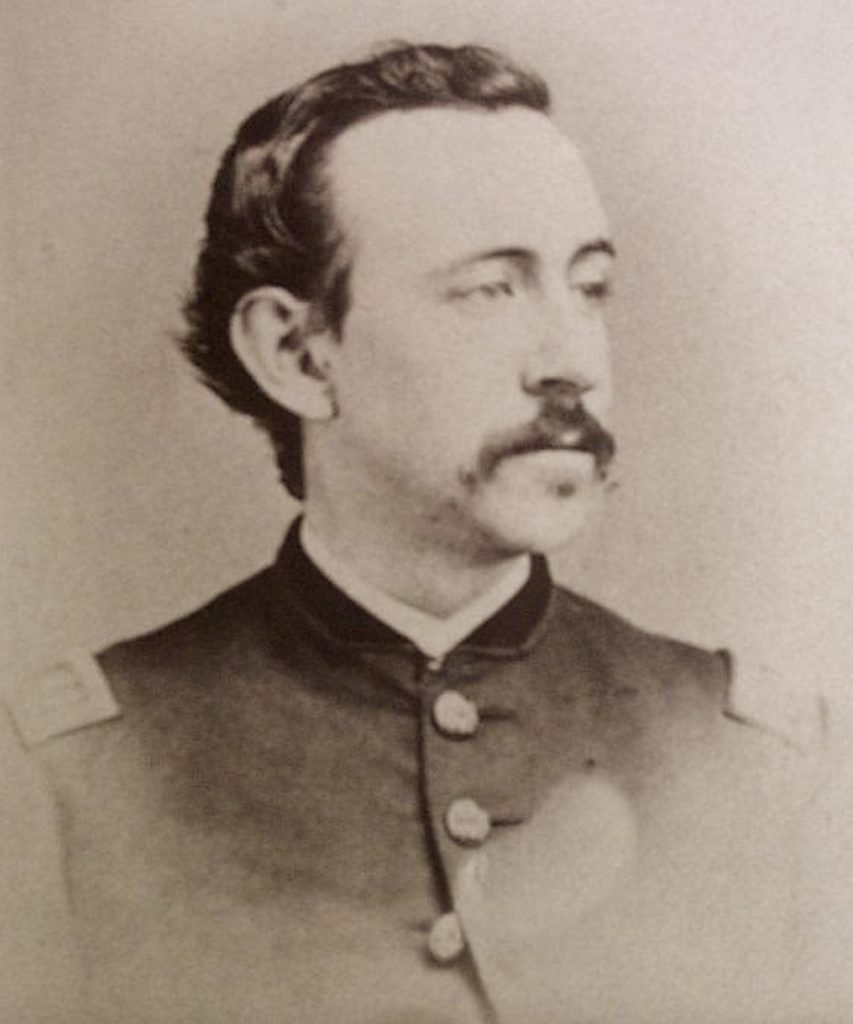
MARCHANT, HENRY A. (1840-1864). Captain, 23rd Pennsylvania Infantry, Companies H, G, F, and I. Born in Ohio, Henry Marchant’s father was the noted portrait artist, Edward Dalton Marchant (see). The family settled in Philadelphia, Pennsylvania, in 1854. According to the 1860 census, Henry Marchant was a painter of miniatures and was listed as a portrait painter in the Philadelphia Directory. During the Civil War, he enlisted at the Schuylkill Arsenal in Philadelphia as a first lieutenant and was commissioned into Company H of the 23rd Pennsylvania, also known as Birney’s Zouaves, on August 2, 1861. Ultimately, in 1864, when Marchant was wounded at the Battle of Cold Harbor, he took out his pocket handkerchief and used it as a tourniquet on his thigh wounds, just as he had taught his men, to reduce the loss of blood. Sadly, it was of no use; his body was soon riddled with bullets, and he died.
Concurrently, in December of 1862, his father, an anti-slavery advocate, was commissioned by the Union League of Philadelphia to paint a portrait of Abraham Lincoln for display at Independence Hall. That portrait would depict Lincoln after signing the Emancipation Proclamation. During Marchant’s service, he was transferred to Companies G and F within the regiment, and was promoted to captain on January 1, 1863, effective upon his transfer that day to Company I. On February 27, 1863, President Lincoln wrote to Major General Joseph Hooker asking that Captain Henry Marchant be excused for five days to help his father with the execution of the portrait for Philadelphia. On March 5, Lincoln asked that the leave be extended for another five days. Marchant’s regiment served in Virginia at Seven Pines, Malvern Hill, Fredericksburg, Mine Run, and Cold Harbor, and at Gettysburg, Pennsylvania. On June 1, 1864, he was shot in the head and killed in action at Cold Harbor. His obituary in the Philadelphia Inquirer captured his spirit and values:
In the countless and bloody struggles caused by this atrocious insurrection, few have fallen more deserving of a place on the roll of honor than Captain HENRY A. MARCHANT, son of the artist of that name. Fired by the fall of Sumter, he immediately enlisted in the cause of his country. An efficient soldier, unusually vivacious, and the very soul of cheerfulness, he inspired his comrades in arms, and became early a favorite and elicited their esteem and praise. Colonel Ely, late of the Twenty-third Pennsylvania Volunteers, in a letter of sympathy to his father, says of him:-“Your talented, noble, brave and generous son was the brightest jewel of this regiment. His quick perceptions, gentle manners and true courage made for him a lodgment in my heart’s memory that will cease only with my –. In the camp, on the march, in the heat of battle on many bloody fields, I have seen your son’s fidelity to truth, honor and patriotism tested, and never was he -–wanting in any of the qualities that make the true man.”
The connection of Captain Marchant with the Twenty-third Pennsylvania Volunteers dates from the first battle of Bull Run. He left Philadelphia for the seat of war the 1st of June, 1861, and remained in the service until he fell in battle of Cold Harbor, on the 1st of June, 1864, thus fulfilling his agreement with his country for three years to the very day: he fell while storming this enemy’s entrenchments, at the head of his command….
…His heart sickened at the sight of the carnage he was so often called upon to witness. It was a sense of sacredness of the cause, and the duties which it devolved on him, that made him cool under privation and suffering, where fortitude and endurance were required.
His refinement was beautifully illustrated in a collection of delicate flowers and ferns which he culled from the various battle-fields and points of note and interest visited by the Army of the Potomac. These were pressed by him, probably between the leaves of his diary, and sent home from time to time. They have been carefully preserved, and form a lovely testimony to that delicacy of taste and sentiment which even the horrors of war could not obliterate.
This young, brave and noble officer has not died in vain. The heroic example of his patriotism and devotion to the cause of liberty will stimulate his brother soldiers to greater deeds of valor, and enlist the youth of the nation for the restoration of that glorious Union which yet shall be restored and protect and shelter the oppressed of every land.
After a funeral at his father’s house on Locust Street in Philadelphia, his body was carried by train to Brooklyn where he was interred at Green-Wood on June 15. In 1885, Rebecca Marchant, his mother was awarded a pension, certificate 222,636. As per the Congressional Record of March 18, 1886, Rebecca Marchant submitted many documents in support of her pension request which indicated that Henry provided partial support for his family. Apparently, her initial requests were denied because it was assumed that her husband, an accomplished artist who had a house in Philadelphia that sold for $8,000, supported her adequately. In fact, Edward Marchant’s actual income in 1864 was small, the funeral expenses of Henry were paid for by friends, and the $2,000 that Edward Marchant paid as a down payment on the aforementioned property was loaned to him by friends. After that house was sold to the Midnight Mission, Marchant purchased another house which was ultimately seized by the sheriff and sold. The Marchants depended on the generosity of friends for their sustenance. In addition, Edward Marchant suffered from an inguinal hernia, dyspepsia and other ailments that impeded his ability to work while Rebecca Marchant was unable to earn money from needlework after rheumatism crippled her hands. Edward Marchant’s portrait of Lincoln now hangs at the Union League of Philadelphia. Section 27, lot 5267.
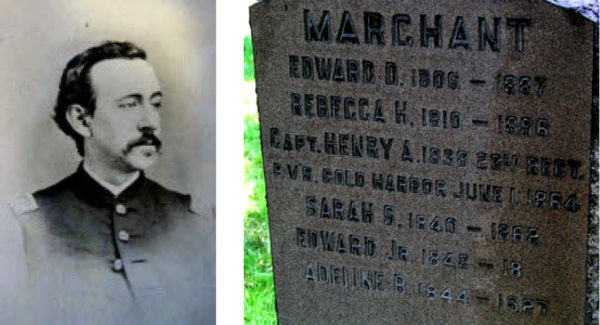
MARKOE, PETER J. (1843-1911). Acting ensign, United States Navy. Originally from Mexico, Markoe enlisted as a mate in the United States Navy on May 8, 1862. He served on the USS Cimarron and the USS Pawtuxet from May 8, 1862, through April 21, 1865. The Pawtuxet was a revenue cutter built in New York at a cost of $103,000, launched on July 7, 1863, and dispatched to Boston on September 29, 1864. It was part of the United States Revenue Marine that plied the waters off Rhode Island and Massachusetts. He was promoted to acting ensign on January 14, 1864. He resigned on April 21, 1865, when he was discharged from the Navy.
According to the censuses of 1870 and 1880, Markoe was working as a bank clerk; the Brooklyn Directory of 1888-1890 and the census of 1900 list him as a clerk. His Civil War service was confirmed by his listing in the 1890 Veterans Schedule. On February 27, 1894, Markoe became a naturalized citizen. He received a pension from the Navy, certificate 36,387. He last lived at 269 Westminster Road in Brooklyn. His death was attributed to paralysis. His wife applied for and received a widow’s pension, certificate 721,338. Section 151, lot 16469.
MARRENNER (or MARRENGER, MARRINER), DAVID J. (or I.) (1821-1890). Private, 7th Regiment, New York State Militia, Company F. A New York City native, Marrenner enlisted in 1842 in the 27th New York State Militia and served in the 6th Company (which later became the 7th Regiment). In 1849, he left for the California during the Gold Rush, sailing around Cape Horn, and then became the editor of the Marysville Herald which was published from the gold fields. In 1852, he returned to New York City and became a partner in Heroy and Marrenner, a glass importing house, at 124 South Fifth Avenue. He volunteered in 1861 to serve 30 days with the 7th Regiment. In 1865, his son Edward Marrenner (see) joined the business. His obituary in The New York Times noted that he was a reader of that newspaper almost since its first publication, an independent in politics and retired two years before his death. He last resided at 225 West 11th Street, Manhattan. His death was attributed to cancer. Section 69, lot 6652.
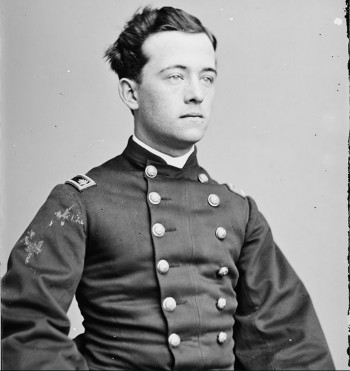
MARRENNER (or MARRINNER, MARINER), EDWARD (1843-1909). Major and acting assistant adjutant general, United States Volunteers Adjutant General Department; captain, 174th New York Infantry, Company I; 162nd New York Infantry, Company I; private, 7th Regiment, New York State National Guard, Company F. Born in New York, Marrenner enrolled there in the 7th Regiment to serve three months, mustered in as a private on May 25, 1862, and mustered out with his company on September 5 at New York City. On October 22, 1862, he re-enlisted at New York City as a first lieutenant, was commissioned into the 174th on that day, was promoted to captain on November 29, 1863, and transferred into the 162nd New York on February 17, 1864. Discharged for promotion to major and assistant adjutant general on October 23, 1864, he was commissioned into the United States Volunteers Adjutant General Department on that day, served as assistant adjutant general to Major General Winfield Scott Hancock, and resigned on June 5, 1865.
According to the census of 1870, Marrenner was living in East Orange, New Jersey, and was employed as a glass importer. His firm, Heroy, Struthers and Company (he replaced Struthers), began manufacturing mirrors in 1870 and became one of the principal glass importers and distributors of American plate and window glass with branches in Philadelphia, Pennsylvania, and Chicago, Illinois. On April 20, 1875, an article in The New York Times stated that he and Boss Tweed were jointly sued and a bill of particulars would be presented to them by the city. In about 1885, an oil painting of Marrenner’s service record was created for him as a testimonial to his participation in the Civil War; it is now in the collection of The Green-Wood Historic Fund. In 1897, he applied for and received an invalid pension, certificate 1,015,455. By 1900, he was living in Chicago, Illinois, where he last resided. His death was attributed to Bright’s disease. His father, David Marrenner (see), is buried in the same lot. Anna M. Marrenner, applied for and received a widow’s pension in 1909, certificate 694,201. Section 69, lot 6652.
MARRYATT (or MARRYOTT), PETER B. (1845-1917). Private, 28th New Jersey Infantry, Company B. Marryatt, a native of Jamesburg, New Jersey, enlisted as a private on September 3, 1862, and served with the 28th New Jersey. On September 1, 1891, he mustered into the Clarence D. Mackenzie (see) Post #399 of the G.A.R.; at that time, he lived in Brooklyn and worked as a carpenter. Marryatt’s application for an invalid pension was approved in 1893. A widower, he was admitted to the Soldiers’ Home in Bath, New York, in 1915; he died there from sclerosis. Section 131, lot 33472, grave 1.

MARSDEN, THOMAS (1825-1900). Private, 78th New York Infantry, Company B. Born in England, Marsden enlisted as a private at New York City on November 14, 1861, and mustered into the 78th New York that same day. He was discharged for disability on February 4, 1863, at Washington, D.C. The 1870 census and the 1873 Brooklyn Directory report that he was a bookbinder. Although he applied for an invalid pension in 1873, application 182,369, it was never certified. The Brooklyn Directories for 1882, 1891, and 1897 all state that he was a bookbinder. His last residence was 85 Quincy Street, Brooklyn. Marsden’s death was attributed to cerebral softening. Section 182, lot 9371, grave 2.
MARSEILLES (or MARCELLUS), ADREAN (or ADRIAN) (1834-1864). Seaman, United States Navy. Marseilles was born in New York City. The census of 1850 notes that he lived in Greenburgh in Westchester, New York. He was the brother of Joseph Marseilles (see). On January 1, 1855, he married his wife Hester. In 1856, he and his wife were living at 185 Chambers Street in Manhattan when their daughter, Mary Ann, was born; their son, John, was born in 1857. The New York City Directory for 1857 lists him as a carpenter. Marseilles was a member of a volunteer fire company.
During the Civil War, Marseilles enlisted as an “able” seaman at New York City on July 15, 1861; although the enlistment information cites two years of previous Naval service, that service is not noted on other Naval records. A carpenter by trade, he was 5′ 5″ tall with dark eyes, black hair and a light complexion. As per his pension application, while attached to the Potomac, he contracted phthisis pulmonalis (tuberculosis) during a storm at sea. Records under the name of Adrian Marcellus indicate that he was in the New York City Navy Hospital from March 17, 1864, through April 20, 1864; he was officially discharged from the North Carolina the next day. On April 25, 1864, he applied for and received a disability pension of $8.00 per month from the Navy, certificate 2,449; his disability was deemed total and permanent. When he died on June 19, 1864, he lived at 48 Charlton Street in New York City. His children, Mary Ann and John, applied for and received a minor’s pension, certificate 1,903. On January 26, 1874, his widow applied for a pension; it was rejected because she remarried and did not file her claim within the time constraints. Section 47, lot 7355.
MARSEILLES, JOSEPH V. (1840-1876). Sergeant, 83rd New York Infantry, Company L; 97th New York Infantry, Company H. Born in New York City, he is listed on the 1850 census as having a twin sister named Gertrude; he was the brother of Adrean Marseilles (see). Marseilles is listed as a student at the New York Free Academy from 1856-1857. After enlisting at New York City on November 14, 1861, as a private, Marseilles, immediately mustered into Company L of the 83rd New York. He was promoted to corporal on June 15, 1863, and to sergeant on October 22. On May 10, 1864, he was wounded at Laurel Hill, Virginia, at Spotsylvania Court House, and transferred into Company H of the 97th New York the next month on June 7. On October 4, 1864, he applied for and received an invalid pension, certificate 34,834.
In civilian life, Marseilles was a clerk at the Post Office. As per his obituary in the New York Herald, he was a Freemason and member of the 9th Veterans Association (the 83rd was also known as the 9th Militia); members were invited to attend his funeral. He last lived at 165 West 11th Street in Manhattan. He succumbed to consumption. Section 47, lot 7355.
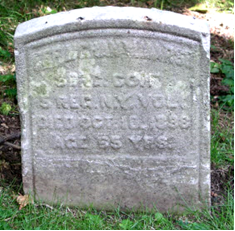
MARSH, EFFINGHAM W. (1832-1898). Second lieutenant, 145th New York Infantry, Company A; sergeant, 5th New York Infantry, Company F. A native of New York City, Marsh was 5′ 6″ with blue eyes and light hair. At the time of enrollment, he resided at 373 Henry Street in Brooklyn and was working as a clerk and merchant. On April 25, 1861, he enlisted as a private at Fort Schuyler, New York, and mustered into the 5th New York, also known as Duryée’s Zouaves, on May 9. He was promoted to corporal on August 14, and to sergeant on January 20, 1862, but was reduced to ranks on or about February 15. Wounded in both legs and in the left hand on August 30, 1862, at Second Bull Run, Virginia, he was captured that day and paroled three days later. After being hospitalized in Alexandria, Virginia, he was discharged for promotion and transferred to Company A of the 145th, where he was commissioned second lieutenant on November 11. Marsh was dismissed on August 18, 1863. On July 24, 1864, he applied for an invalid pension which was approved in June 1865 for $4 per month, certificate 44,010.
The 1870 census states that Marsh was an edge gilder whose personal worth was $1,000. The 1878 Brooklyn Directory lists him as a bookbinder; he is identified as a gilder in the 1880 census. Marsh’s obituary in the Brooklyn Standard Union, which confirms his Civil War service, reports that he was a gilder in the binding department of the New York Bible House for forty years. That obituary indicates that he was a member of the Devin Post #148 of the G.A.R. He was also a member of Morrell Post #144 of the G.A.R. in Ossining, New York. As per his obituary in the New York Sun, he was a member of the Guilders’ Association of New York. He last lived at 115½ 2nd Place. Section 171, lot 13253.

MARSH, JAMES H. (1840-1912). Sergeant, 37th Regiment, New York State National Guard, Company A. Marsh graduated from the University of the City of New York just before the onset of the Civil War. The 1860 census reports that he was a bookkeeper. As per his obituary in the New York Herald, which confirms his Civil War service, Marsh first served in the 7th Regiment, then became a dispatch bearer on the USS Minnesota. He was onboard that vessel during the historic battle of the USS Monitor v. the CSS Virginia (Merrimac) at Hampton Roads, Virginia, in March 1862, and received a slight wound during that engagement. He enlisted as a sergeant on May 29, 1862, at New York City, mustered immediately into the 37th New York, and mustered out after three months on September 2.
After the War, Marsh was employed in government service in Washington, D.C. The 1880 census indicates that he was a clerk in New York. The 1890 Veterans Schedule confirms that he was onboard the USS Minnesota. In 1891, his application for an invalid pension was approved, certificate 979,294. (Marsh’s pension index only states that he served in the 37th Regiment making no mention of his other service.) The 1900 and 1910 censuses report that he was a bookkeeper. His last residence was 129 West 12th Street, Manhattan. Shortly after his death from pneumonia in 1912, Helen Marsh, who is interred with him, applied for and received a widow’s pension, certificate 753,803. Section 70, lot 2026.
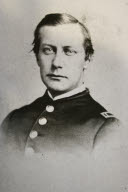
MARSH, WALTER RAYMOND (1838-1872). Regimental quartermaster, 15th New York Engineers, Companies B and C; corporal, 22nd Regiment, New York State National Guard, Company A. A native of New York, school records state that Marsh was a sophomore at the University of the City of New York in 1857, graduating with a Bachelor of Arts degree in 1859. (The school is referred to as N.Y.U. in his biographical sketch from that institution.) An excellent student, he was a member of the honor society, Phi Beta Kappa, and was the commencement speaker. Marsh went on to study law at Albany Law School, earning a law degree in 1860. He is also listed as a member of the senior class at Columbia College in 1861.
During the Civil War, Marsh enlisted as a corporal at New York City on May 28, 1862, mustered immediately into the 22nd Regiment, and mustered out three months later at New York City on September 5. Marsh re-enlisted as a first lieutenant at Washington, D.C., on November 4, 1862, and was commissioned into Company B of the 15th New York Engineers a week later. He became a first lieutenant on June 18, 1863, was transferred immediately to Company C but upon his appointment that day to regimental quartermaster, he moved to the Field and Staff. On November 11, 1864, he mustered out.
Marsh then resumed his education, earning a Master of Arts degree from N.Y.U. in 1865. He then practiced law. The 1870 census indicates that he was employed as a broker, owned real estate and had a personal estate of $600. His last residence was in Cornwall, New York. His death was caused by phthisis (tuberculosis.) In 1908, his widow, Mary Scott Marsh, applied for and received a pension, certificate 657,907. Section 26, lot 3817.
MARSHALL, JOHN WORRALL (1837-1914). Assistant paymaster, United States Navy. Marshall was born in Albany, New York. According to his obituary in The New York Times, he was an assistant paymaster in the Navy during the Civil War and then was a lieutenant in Company D of the 23rd Regiment after the War. Further details of his service are not known. In civilian life, he was in the paper manufacturing business with Vernon Brothers & Co. and then with the Blauvelt-Wiley Paper Manufacturing Company. The 1880 census indicates his employment as cashier/paper; the Brooklyn Directory for 1885 lists him as a cashier. The 1900 census and the 1904 Brooklyn Directory report his occupation as “paper.” In addition, Marshall was a member of the 23rd Regiment Veterans’ Association. In 1911, Marshall applied for a pension, application 1,400,232, but it was never certified. He last lived at 572 Classon Avenue in Brooklyn. His death was caused by nephritis. In 1916, Grace Marshall, who is interred with him, applied for a widow’s pension, application 1,081,462, but it was never approved. Section 166, lot 28327.
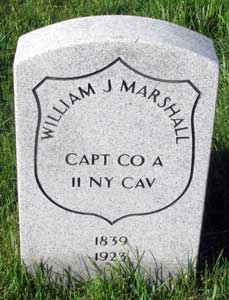
MARSHALL, WILLIAM J. (1839-1923). Captain, 11th New York Cavalry, Company A. He enlisted as a captain on January 23, 1862, and entered his unit on that date. Marshall resigned on June 18, 1862. His last residence was 276 10th Street in Brooklyn. Section 15, lot 17263, grave 2494.
MARSTON (or MARSTOW), ALEXANDER (or ALEX) B. (1829-1879). First lieutenant, 145th New York Infantry, Company A. Born and living in New York, the 1857 New York Directory lists Marston as a carpenter. The census of 1860 reports that Marston was married with three young children; he was employed as a sawyer (woodcutter) and had a personal estate worth $200. During the Civil War, he enlisted on June 21, 1862 as a first lieutenant at New York City and mustered into 145th on September 11. He was commissioned into his regiment on October 10 with rank from August 31, 1862. On January 24, 1863, he was discharged with his company under the name Alexander B. “Marstow.”
In addition to his employment as a sawyer, Marston may also have been a police officer. According to his descendant, an Alexander Brown Marston, who he believes is the same man, resigned from the 11th Precinct as a policeman on July 6, 1862, as per an article in The New York Times; another article in The New York Times indicates that Marston was appointed to the 17th Precinct, Metropolitan Police during the week ending April 12, 1863. He was living in Bridgeport, Connecticut, in 1874, and was listed in that city’s directory as a foreman at Hawley & Beecher’s. The 1879 New York City Directory indicates that he was a sawyer at 282 Stanton Street in New York City. Section 192, lot 24390.
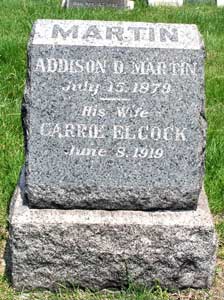
MARTIN, ADDISON D. (1838-1879). First lieutenant, 84th New York (14th Brooklyn) Infantry, Company E. Martin was born in Missouri. After enlisting at Brooklyn on April 18, 1861, he mustered into the 14th Brooklyn as a sergeant on May 23. He was promoted to second lieutenant on May 24, 1863, and to first lieutenant on November 2, 1863. Martin mustered out on June 6, 1864, at New York City. He was the brother-in-law of George Sharpe Elcock (see), a captain of the 14th Brooklyn.
The 1870 census indicates that Martin worked as a bookkeeper; he is listed as a clerk in the 1870 Brooklyn Directory and as a secretary in the 1871 Brooklyn Directory. As per his obituary in the Brooklyn Daily Eagle, he worked as a hospital steward at the Brooklyn Navy Yard until he was incapacitated by tuberculosis, which resulted in his death. That obituary notes that after the funeral ceremonies at his house, the cortege that preceded the hearse was led by Captain Cordona and a contingent from the 14th Regiment. Eight veteran officers of equal rank to the deceased were the pallbearers and a detachment of about thirty military officers and veterans followed the hearse to Green-Wood where three volleys were fired at graveside in tribute to Martin. His last residence was on 3rd Street, near Fifth Avenue, in Brooklyn. In 1880, Carrie (or Caroline) Martin, who is interred with him, applied for and received a widow’s pension, certificate 241,303. Section 11, lot 2650.
MARTIN, BENJAMIN ELLIS (1839-1909). Assistant surgeon, 5th New York Infantry. An 1861 graduate of the College of Physicians and Surgeons at Columbia University, Martin was the eldest son of David Randolph Martin, the president of Ocean National Bank, New York City. He enlisted at New York City, his birthplace, on April 25, 1861, was commissioned into the Field and Staff of the 5th New York Infantry (Duryee’s Zouaves) as an assistant surgeon on May 14, and resigned on February 8, 1862, because of ill health.
Martin later served as ship’s surgeon for the Pacific Mail Steamship Company and port surgeon of the line at San Francisco, California. A world traveler, he was a member of the last Agassiz expedition to South America. Subsequently, he was appointed U.S. Consul at Brunswick, Germany, and spent many years in Europe, traveling and writing. His best known books are About England with Dickens, Old Chelsea, In the Footprints of Charles Lamb, and The Stones of Paris in History and Letters. After returning to his native New York City, Dr. Martin became a member of the Century Association and the Players’ Club. In 1908, Martin applied for and received a pension, certificate 1,145,287. He died of nephritis at his home in the Chelsea Apartments, 222 West 23rd Street, Manhattan. Section 29, lot 10584.
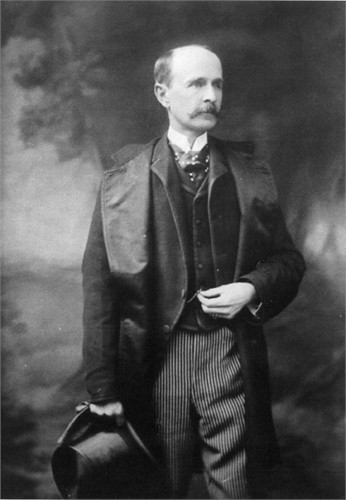
MARTIN, BRADLEY (1841-1913). First lieutenant, 93rd Regiment, New York State National Guard, Company F. Originally from Albany, New York, Martin was educated there at Union University. After enlisting at New York City as a first lieutenant on July 20, 1864, he was immediately commissioned into Company F of the 93rd Regiment. His obituary in the Philadelphia Inquirer, which confirms his Civil War service, notes that he commanded a company for a short time and was an aide-de-camp to Gov. Reuben E. Fenton. He mustered out on November 1, 1864, at New York City.
He and his wife, Cornelia Sherman Martin, were leaders of New York society for many years. The Martins inherited between $5,000,000 and $6,000,000 when Cornelia’s father died in January 1881. The Martins then renovated and enlarged their home on West 20th Street in Manhattan, took a trip to Europe where they leased an estate in Scotland and where, in 1893, their daughter, Cornella, became the Duchess of Craven after her marriage to the Earl of Craven.
Upon returning to New York for the winter season, the Martins began entertaining lavishly. Their festive balls at their home and at Delmonico’s Restaurant attracted widespread attention for both their decorations and elaborate favors. The extravagant masquerade ball that they gave at the Waldorf Hotel in 1897 was a landmark in New York City’s social history. Widely scorned for elaborate spending during a recession, they spent much of their time thereafter in Scotland, London, and Paris, and became a part of European society. His obituary in the Daily People (New York) noted that Martin ironically mocked the socialists who condemned his “perverse” spending abroad when he chose to be buried in America. He died from pneumonia, a complication of influenza, in London. Section 150, lot 1349.
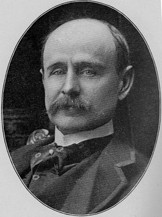
MARTIN, COLIN A. (1844-1913). Musician, 139th New York Infantry, Company G. Originally from London, England, Martin immigrated to the United States in 1848. During the Civil War, he enlisted as a musician at Brooklyn on August 15, 1862, and mustered into the 139th on September 9. He was discharged from military service on April 30, 1865.
The 1870 census reports that Martin was a shoe fitter. On July 14, 1884, he mustered into the John Sedgwick Post #186 of the G.A.R. He is listed as a salesman in the 1888 Brooklyn Directory, as a drummer in the 1891 Brooklyn Directory, and as a salesman in the 1898 Brooklyn Directory. In 1898, his application for an invalid pension was granted, certificate 1,027,807. The 1900 census states that he was in the shoe business and the 1904 Brooklyn Directory reports that he worked as a salesman. The Copartnership and Corporation Directory of the Boroughs of Manhattan and the Bronx of March 1908 report that he was an agent of the Franklin Shoe Company of Boston. As per his obituary in the Brooklyn Daily Eagle, which confirms his Civil War service, he was a member of the James McQuade Post #557 of the G.A.R. and was president of the 139th New York Veterans (elected on December 11, 1911); comrades from both organizations were invited to attend his funeral. He last resided at 1035 Halsey Street in Brooklyn. He succumbed to cirrhosis of the liver. His widow, Martina A. Martin, who is interred with him, applied for and was granted a pension in 1913, certificate 771,436. Section 168, lot 16268.
MARTIN, GEORGE M. (1839-1890). Second lieutenant, 84th New York (14th Brooklyn) Infantry, Company C. Born in Newark, New Jersey, and a carpenter by trade, Martin enlisted on April 18, 1861, and mustered into the 14th Brooklyn on May 23. He was promoted to first sergeant on March 1, 1863, and to second lieutenant on May 27, 1863. At the Battle of Gettysburg, Pennsylvania, on July 1, 1863, he incurred a slight wound to the head. He mustered out on June 14, 1864, at New York City.
The 1868 and 1872 Brooklyn Directories and the 1870 census indicate that Martin was a bookkeeper. The 1881 Brooklyn Directory reports that Martin was a clerk and the 1886 Brooklyn Directory lists him as a bookkeeper. At one time, he worked for the post office but according to an article about his suicide in the New York Tribune, lost that job after he was jailed for robbing the mails. At the time of his death, he had lost his position as a bookkeeper for the Mica Roofing Company.
The article in the New York Herald on November 13, 1890, which confirms his Civil War service, states that he committed suicide at the Raymond Street Jail in Brooklyn where he was confined to cell #16 after being convicted of grand larceny. All articles note that contrary to policy, Martin had a penknife which he used to gash his wrist and repeatedly stab himself in the left breast. He left a note which read, “If there is a hell in another world any worse than the one I have just been through on this earth, I’ll take my chances, and would have done so long since but for the hope that in living I might in a measure make amends for the persistent self-sacrifice and devotion of a loving wife, but now I give it up.” A third article on his death in the Brooklyn Daily Eagle reported that his wife, who came from a well-respected family, had tried to repay the loan that her husband secured but that lender could not be located. She had hoped that her husband would have been released from jail upon repayment. The Brooklyn Daily Eagle article notes that Martin was also a drinker who had struggled to support his wife. He last lived at 200 44th Street in Brooklyn. Shortly after his death, Adriana Martin, who is interred with him, applied for and received a widow’s pension, certificate 333,291. Section 43, lot 267.
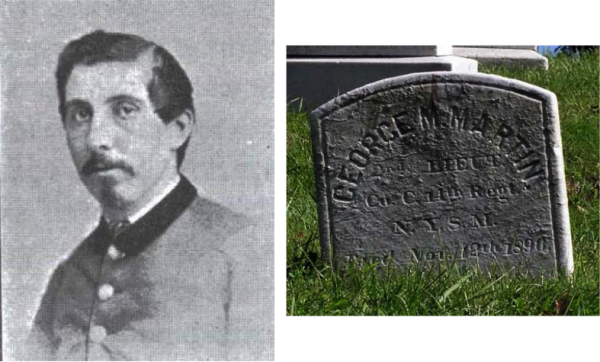

MARTIN, GUY C. (or CHARLES) (1840-1862). Corporal, 6th Vermont Infantry, Company K; private, 1st Vermont Infantry, Company A. A native of Westport, New York, Martin resided in Swanton, Vermont, at the onset of the Civil War. He enlisted as a private on May 2, 1861, mustered into Company A of the 1st Vermont seven days later, and mustered out on August 15, 1861. He re-enlisted as a corporal at Montpelier, Vermont, on September 25, 1861, and mustered into the 6th Vermont on October 15, 1861. As per his muster roll, he was a farmer who was 5′ 10″ tall with blue eyes, light brown hair and a light complexion. Martin was wounded at the Battle of Savage’s Station, Virginia, on June 29, 1862. The date of his death is unclear. As per articles in the Lamoille Newsdealer [Vermont] on August 9, 1862, and The New York Times on July 14, 1862, Martin was brought to Long Island College Hospital; The Times article listed him among the casualties with wounds to the left leg and arm. The Vermont newspaper reported that he died on July 17, 1862, after arriving in the hospital in feeble condition stemming from a gunshot wound to the thigh at a battle near Richmond. According to the Lamoille Newsdealer, Martin could only give his name and say “Vermont”; he had no personal effects with him. A subsequent soldier report in 1892 stated that Martin was wounded at the Battle of Savage’s Station on June 29, 1862, and died on July 5; that date is incorrect-July 17, 1862 is the correct date of his death as verified by the resident surgeon of Long Island College Hospital. Also unclear is the cause of death; in addition to reports that he died from a battlefield wound, one document records his cause of death as typhoid fever. He was buried in an area of Green-Wood known as the Strangers Lot, a place where someone with little or no contact in Brooklyn or New York City would have been interred. Hannah Martin successfully applied for a mother’s pension on February 12, 1864, certificate 51,387, erroneously indicating July 5, 1862, as her son’s date of death. Hannah Martin, a widow, claimed that her son supported her; she was awarded $8.00 per month.
On August 18, 1869, The Burlington Free Press [Vermont] published an article noting that the town of Swanton, where Martin resided at the time of his enlistment, formally dedicated a monument to its fallen heroes (picture below). The people from the area gathered in the village where ceremonies were held; they were joined by a brigade band and about 400 people who arrived by train from St. Albans, Vermont. The article goes on to say that there was a procession to the monument in a beautiful section of the park; at the time it was the only monument of its kind in the region. The townspeople raised $1,500 for the imposing monument whose marble came from the Isle La Motte quarry; the cost had risen to $2,000 by the time the monument was put in place in 1868. The marble base of the structure was topped with a pure white marble Grecian “Goddess of Liberty”; the marble was from a quarry in Rutland, Vermont. The inscription on the north face of the die (the main part of the monument) reads: “Erected By The Town of Swanton/ In Memory Of/Her Patriot Soldiers/Who Fell In The/War Of The Rebellion.” The names of the 29 soldiers from the town of Swanton who died during the Civil War, along with their ranks, regiments, causes and dates of death, were engraved on the south, east and west sides of the die. Martin’s date of death is incorrectly listed on the monument as July 5, 1862. Section 42, lot 283 (Strangers Vault).
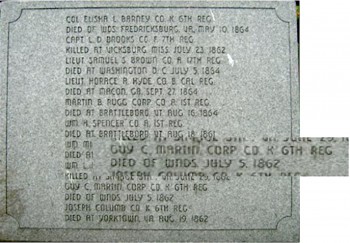
MARTIN, HENRY (1841-1909). Sergeant, 79th New York Infantry, Companies D, A, and B. A native of Ireland, he lived in Albany, New York, until the Civil War. Martin enlisted as a corporal at New York City on May 28, 1861, and immediately mustered into Company D of the 79th New York, also known as the Highlanders. He was promoted to sergeant on February 1, 1864, transferred to Company A on May 31, and then to Company B on July 31. He mustered out on September 12, 1864. His obituary in The New York Times confirms his Civil War service. He last lived at 682 Park Place in Brooklyn. He left each of his four children $1,000; Green-Wood $200, and the rest of his estate, totaling about $2,000 to his wife, Margaret, who is interred with him. Section 200, lot 29993.
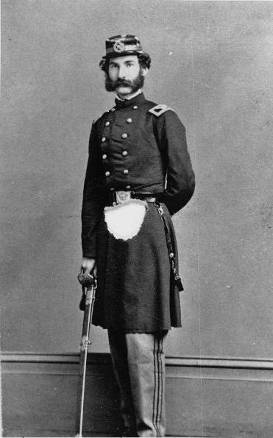
MARTIN, HENRY PATCHEN (1827-1906). Colonel, 71st Regiment, New York State National Guard. Born in New York City, his father was a prominent merchant who was active in the pursuit of honest government, especially in his home state of New Jersey. In 1849, Henry Martin joined the Continental National Guards, became an accomplished soldier and drill officer, and tendered his resignation in 1857. At the onset of the Civil War in 1861, at the urging of Abram Vosburgh (see), he became lieutenant colonel of the 71st New York State Militia. He enlisted at New York City on April 19, 1861, was commissioned lieutenant colonel, and took command of the regiment after Vosburgh’s death on May 20. Promoted to colonel on June 3, he faced his troops on July 20, 1861, at Centreville, Virginia, the date when the regiment’s service officially expired. Martin said to his men:
You are all aware that your term of service ends today, legally you are free to turn back and march to New York, no legal claim rests upon you to remain, nor will any restraint be put upon your action, every man is free to go who wants to go, I only tell you that we are within a few miles of the enemy, at any moment you may hear the cannonade which will begin a battle that may result in the preservation or the destruction of our Union. I will not urge you to any course of action, I leave the decision to each man’s sense of duty.
After a pause, he continued, “If any man is not willing to prolong his term of service let him step three paces to the front.” Only one man stepped forward, and Martin told the adjutant, “Remove the stripes from that man’s arms and cut off his buttons.” When 100 men were asked to extend their duty ten days, all stepped forward but ultimately Martin was told that the detail was not required. He commanded the regiment at the first Battle of Bull Run, Virginia, on July 21, 1861, where he kept his men together and received accolades for his cool manner and discipline despite the decimation of his regiment which lost 75 men. He mustered out on July 31 at New York City.
When the regiment was reactivated a year later and part of the National Guard, Martin was commissioned into the 71st on May 28, 1862. When the 71st showed up in Washington for three months service, Secretary of War Edwin Stanton at first told Martin that regiments pledged to serve for three months were not welcome. This was not an acceptable answer for the colonel and his loyal troops who were turned away from the barracks and were not sheltered until they were allowed to sleep on the floor of the unfinished Capitol. After meetings with Lincoln, and then New York Senator Preston King and the secretary of war, Martin was ultimately told by Stanton, “Well, Colonel, if your regiment will be mustered in I will give you my word of honor that it shall not be detained beyond an hundred days, and I will give orders to have it rationed and assigned to duty.” The troops mustered out at New York City after three months on September 2, and Martin resigned on September 23, refusing to deal again with the politics that he faced that year.
According to a sketchbook of the 71st, he was venerated by his charges that looked up to him like a father and he, likewise, considered them his sons. Subsequently, he organized the 71st Veteran Association in 1869 and was its first president. On April 22, 1881, The New York Times published an article on a dinner celebration at Delmonico’s Restaurant commemorating the 71st’s 20th anniversary of their departure to the Civil War; 85 veterans and their guests toasted Colonel Martin and others. The regimental band played at the event and letters from President James Garfield, General Ulysses S. Grant and others were read. He mustered into the Lafayette Post #140 of the G.A.R. on December 6, 1895. His obituaries in the Yonkers Statesman, Brooklyn Standard Union, Brooklyn Daily Eagle and the Evening Post confirm his Civil War service and participation at the Battle of Bull Run. The Brooklyn Standard Union stated that Martin achieved fame at Bull Run when he ordered his men to wear their dress uniforms in that engagement. The obituaries noted that he presented the 71st with a bronze tablet designed by Tiffany Company and inscribed with the names of the men who were killed or wounded during the Civil War; the tablet was saved when the Regiment Armory burned down. In addition, on October 1, 1905, he presented the regiment with a large trophy, known as the Martin Cup, which stimulated interest in small arms practice.
In civilian life, Martin sold pianos and speculated successfully in real estate. An active member of St. Luke’s P. E. Church on Clinton Street, he donated to it over $200,000 in gifts, which was used for the Sunday school building, memorial windows and a magnificent organ. He last lived at 1018 Fulton Street in Brooklyn, a grand home named “Rusurban.” The Martins entertained lavishly at the mansion where he was known as a connoisseur of fine wines and cigars. According to his obituary in The New York Times, members of the 71st Regiment Veteran Association and members of the Lafayette Post of the G.A.R. were requested to attend his funeral at St. Luke’s Church. An article on November 1, 1907, in the Brooklyn Standard Union indicates that two Romanesque panels depicting the Archangels Gabriel and Raphael and executed by Tiffany studios in opalescent glass made specially for the work, were dedicated at St. Luke’s Church in his memory. His death was caused by pneumonia. Martin’s mansion was sold in October 1921, after being on the market for ten years; it then was demolished to make way for an apartment house and parking lot. He bequeathed money to the 71st for an annual celebration of his birthday (November 13), and the 71st still carries on this tradition. An article in The New York Times on November 14, 1958, reported that 250 veterans of the 71st Regiment enjoyed a dinner provided by the fund that Colonel Martin left to celebrate his birthday in perpetuity. As of this writing, that annual dinner continues to be held. Section 92, lot 8154, vault.
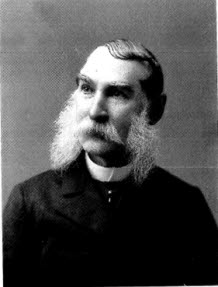
MARTIN, JAMES B. (1832-1871). Private, 79th New York Infantry, Company I. Of Irish birth, Martin enlisted at New York City on May 13, 1861, and mustered into the 79th on May 28. After serving three years, he mustered out on May 31, 1864, at New York City. His last address was 306 Bleecker Street in Manhattan and his death was due to consumption. Section 173, lot 19133.
MARTIN, THOMAS B. (1838-1909). Saddler, 1st New York Cavalry, Company C. A native of Belfast, Ireland, and a shoemaker by trade, Martin enlisted as a private at Philadelphia, Pennsylvania, on July 19, 1861, and mustered immediately into the 1st New York Cavalry, also known as the Lincoln Cavalry. His muster roll notes that he was 5′ 2″ tall with brown eyes, auburn hair and a light complexion. He was promoted to saddler on August 22, 1863. He re-enlisted on January 1, 1864, and mustered out on June 27, 1865.
The 1875 New York State census reports that Martin was a shipping clerk dealing in fancy goods and the 1880 census lists his occupation as clerk in notions. In 1892, his application for an invalid pension was granted under certificate 1,098,391. The 1905 New York State census reports that he was a shipping clerk. An article on August 15, 1908, in the Brooklyn Daily Eagle notes that Martin was elected president of the First New York (Lincoln) Cavalry Association. As per his obituary in the Brooklyn Standard Union, which confirmed his Civil War service, he was a member of the Ulysses S. Grant Post #327 of the G.A.R. His funeral was held at the Grant Post headquarters. At the time of his death from angina pectoris, he resided at 146 Lafayette Avenue, Brooklyn. Section 194, lot 31504, grave 2.
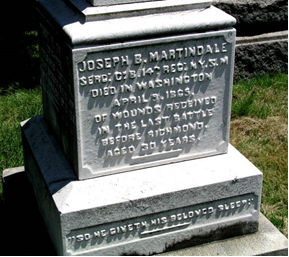
MARTINDALE, JOSEPH B. (1835-1865). Private, 84th New York (14th Brooklyn) Infantry, Company B; 5th New York Veteran Infantry, Company I. A jeweler by trade, he enlisted at Brooklyn on August 26, 1862, and mustered into the 14th the next day. As per his muster roll, he was 5′ 10½” tall with gray eyes, brown hair and a light complexion. He was wounded at Gettysburg, Pennsylvania, on July 3, 1863. Subsequently, he transferred to the 5th New York Veterans on June 6, 1864, and was promoted to sergeant on August 19, 1864. At White Oak Road (also known as Hatcher’s Run, Gravelly Run, Boydton Plank Road, White Oak Ridge), Virginia, on March 31, 1865, he suffered a bullet wound to his left lung, and died of those wounds on April 10, 1865, at Armory Square Hospital in Washington, D.C.
On June 16, 1865, Rebecca Martindale applied for and received a widow’s pension of $8 per month under certificate 80,787. The Martindales had one child, Joseph Jr., who was born in 1862. That son, Joseph Martindale Jr., gained notoriety after his death in 1917 when it was determined that as president of the Chemical National Bank in New York he had embezzled $300,000 from the institution. Section 188, lot 15750.

MARTYN, CHARLES G. (1834-1873). Second lieutenant, 2nd New York Heavy Artillery, Companies I, A, and C. Born in Devonshire, England, and a master mariner, Martyn enlisted as a private on July 23, 1862, at New York City, and mustered into Company I of the 2nd New York Heavy Artillery on that day. His muster roll, which notes that he was also borne on the rolls as Charles Martin, reports that he was 5′ 7″ tall with blue eyes, brown hair and a light complexion. At some point in his military service, he was promoted to first sergeant and transferred to Company A of the same regiment. On March 26, 1864, he was promoted to second lieutenant effective upon his transfer that day to Company C. The following August 14, he was wounded at Deep Bottom Run, Virginia. He was discharged on October 13, 1865, although his official discharge for disability from the War Department was dated January 7, 1865. On October 23, 1865, he applied for and was granted an invalid pension, certificate 5-6 617. On January 7, 1868, Martyn wrote to New York’s Governor Edwin D. Morgan asking his help in securing a brevet promotion to captain. He wrote in part:
…I served during the late War in your Regt., the 2nd New York Artillery, and was honored with a Captain’s Commission in it, but at the time of its receipt, I was severely wounded and an inmate of Armory Square Hospital where you so kindly visited me. Unfortunately for me, I was not able to leave Hospital until after the muster out of my Regt. so that I was never regularly mustered as a Captain, but discharged from the Service as a Second Lieutenant, the rank I held at the time I received the Capt’s Commission.
Need I assure you how bitterly disappointed I felt when that honor was denied me.
May I therefore, without being overbold, ask your aid and influence in procuring me a Captain’s Brevet Commission from the President. (I dare not ask for any thing higher) so that I shall then be entitled to the Rank (Captain) which is now awarded me thru courtesy….
Although Governor Morgan asked President Grant to bestow the honor, the President stamped the request “Not approved.” The 1870 census indicates that Martyn was a clerk at the Custom House where his yearly compensation in 1873 was $2,000. He last lived at 220 10th Street in Brooklyn. His widow, Elizabeth Martyn, applied for and received a widow’s pension in 1874, certificate 165,949. Section 174, lot 21500.
MARVIN, JR., AZOR SMITH (1825-1899). Lieutenant colonel by brevet; captain and assistant adjutant general, 3rd Brigade, Sykes’ Division 5th New York Infantry, Companies A, I, and H. Born in Brooklyn and one of twelve children, Marvin attended preparatory schools in Bedford, New York, and Lawrence, New Jersey. He was a graduate of the College of the City of New York (now New York University) in 1846. An adventurer, he traveled around Cape Horn to reach San Francisco in 1849 during the Gold Rush, opened one of the first bookstores in California, and journeyed around the world from 1854 to 1858. He visited the Sandwich Islands, China, India, Egypt and Europe, then regaled his friends with tales of his experiences throughout his lifetime.
An accountant at the start of the Civil War, Marvin enlisted at New York City on April 25, 1861, and mustered into Company A of the 5th New York, also known as Duryée’s Zouaves, as a private on May 9. After being detailed to the adjutant’s office, he transferred into Company I on September 1, 1861, was promoted to sergeant on November 9, 1861, and to second lieutenant on January 1, 1862. In June 1862, he was detailed as acting assistant adjutant-general on the staff of Colonel Gouverneur K. Warren, and served with him during the Peninsula Campaign. On August 1, 1862, he was promoted to first lieutenant of Company H, and on October 29, 1862, was promoted to captain and assistant adjutant general. After serving with Colonel Warren until the spring of 1864, Marvin was then transferred to the headquarters of the Fifth Army Corps where he served from the Wilderness Campaign to the Weldon Railroad. On January 18, 1865, he resigned. He was brevetted major “for gallant and meritorious service at the battle of Gettysburg, Pennsylvania,” and lieutenant colonel “for gallant and meritorious services during the campaign of 1864, from the Rapidan to the Weldon Railroad, to date March 13, 1865.”
After the Civil War, he was in charge of the Philadelphia, Pennsylvania, branch of his father’s safe business, Marvin & Co. (See image below.) After spending a short time in California, he returned to New York City where he became president of the Marvin Safe Company at 400 Broadway. Remaining active in regimental affairs, he joined the G.A.R. on November 18, 1887, was treasurer of the 5th Veterans Association and on the Warren Monument Committee. In October 1899, his article, “California in ’49,” was published in the Overland Monthly. The Military Order of the Loyal Legion, a veterans organization of which he was a member, gave this tribute upon his death: “He was a gallant soldier, a good citizen, a faithful friend, a natural gentleman, who deserved and won the commendation of his commanders and comrades.” In expressing their sympathy to his family, his comrades noted, “A good soldier has fallen.” He died of pneumonia in Bensonhurst, Brooklyn. Section 119, lot 75.
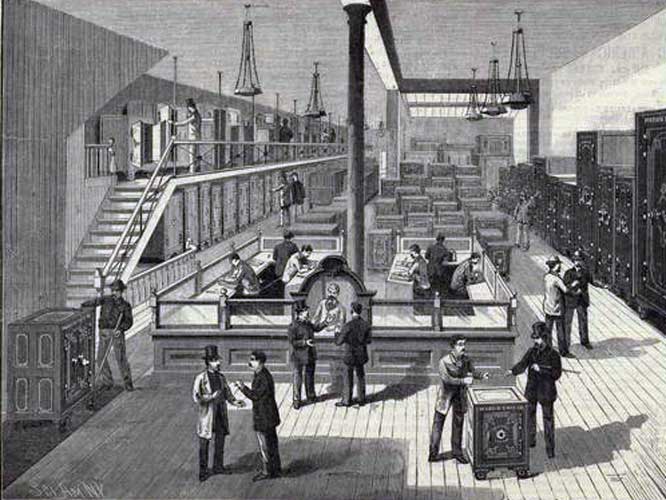
MARVIN, GEORGE HOWARD (1839-1883). Acting assistant surgeon, United States Volunteers; United States Navy. A Brooklynite by birth and employed as a broker according to the 1860 census, Marvin received a bachelor’s degree in 1860 from Williams College. His Sigma Phi fraternity sketchbook notes that he served as an assistant surgeon with an unnamed New York Infantry in May 1861. He was listed as a graduate of Bellevue Hospital Medical College, class of 1864. However, alumni and government records state that he was an acting assistant surgeon with the United States Navy from 1862 through 1865.
As per Navy records, Marvin was commissioned as an acting assistant surgeon on September 20, 1862, and assigned to the USS Isaac Smith. That steamer was sent to patrol Confederate waters to prevent the South from trading with other countries. On January 30, 1863, while on patrol in the Stono River (near Charleston, South Carolina), the ship was caught in a crossfire and surrendered; the Isaac Smith was the only Union vessel captured by Confederate land forces during the Civil War. It is likely that Marvin was taken prisoner at that time. His fraternity handbook from Williams College notes that he also served on the USS Miami. He resigned on March 11, 1865.
Marvin is listed as a broker on the 1870 census. His firm was Marvin Bros., Bankers and Brokers in New York City. In “The Proceedings of the Medical Society of the County of Kings” (1884), noting Marvin’s death, it was reported that he served during the Civil War with the Army and the Navy and was incarcerated for several months at the notorious Libby Prison; no dates are given for his Army service or imprisonment. His last residence was 441 Henry Street in Brooklyn. Section 41, lot 302.

MARVIN, OLIVER WILLCOX (1841-1925). Corporal, 176th New York Infantry, Company I; private, 52nd Regiment, New York State National Guard. After enlisting as a private at Brooklyn on November 11, 1862, Marvin, a New York City native, mustered into the 52nd National Guard on that day, and was transferred to the 176th New York on December 15, 1862. His muster roll states that he was a clerk who was 5′ 5″ tall with gray eyes, light hair and a light complexion. The 176th was sent to Louisiana early in 1863 where it formed part of the garrison around New Orleans during the siege of Port Hudson. Marvin was promoted to corporal on February 28, 1863. After the Confederate victory at Brashear City, Louisiana, on June 23, 1863, the Union garrison at Bayou Boeuf surrendered the next day after realizing that their escape route to New Orleans was closed. Marvin, who was part of the detachment at Bayou Bouef, was taken as a prisoner of war on June 24 (one of 275 prisoners), and subsequently paroled and returned to action on August 17, 1863. He mustered out on November 16, 1863, at New York City.
The 1880 census reports that Marvin was a bookkeeper. At the time of his appointment to the United States Custom House in 1881, he was compensated $1,200 per year. The 1900 census reports that he was a clerk at the Custom House; his annual salary in 1905 was $2,200. In 1905, he applied for and received an invalid pension, certificate 1,106,761. The 1910 census notes that he worked at the Custom House. Marvin was a charter member of the G.A.R.’s Ulysses S. Grant Post #327 and was its adjutant for 1910. On June 22, 1913, the Brooklyn Daily Eagle reported that the fifteen survivors of the 176th who were members of the Ironsides Veterans Association celebrated the 50th anniversary of the Battle of Lafourche Crossing, Louisiana, at an outing at Luna Park. An article in the Brooklyn Daily Eagle on April 23, 1925, about reminiscences of 50-year members of the Plymouth Church in Brooklyn reported that Marvin, a 67-year member, had the longest affiliation with that institution. Although many anecdotes related to the Reverend Henry Ward Beecher (see), Marvin gave a tribute to his late wife whom he met at the Plymouth Sunday School and married at Plymouth Church.
As per his obituary in the Brooklyn Daily Eagle, which confirms his service in the 176th Volunteers, members of the Grant Post were invited to attend his funeral where the Grand Army ritual would take place. His last residence was 458 Macon Street in Brooklyn. According to an article in The New York Times on December 30, 1925, his estate was appraised for $47,945 (net $46,811, equivalent to about 630,000 in 2014 dollars), of which his house was worth $12,000; bank deposits $13,428; stocks and bonds $21,306; personal effects $650; insurance $331; and salary $230. His death was attributed to chronic myocarditis. Section 56, lot 8749.
MARVIN, STEPHEN L. (1832-1868). Sergeant, 83rd New York Infantry, Company E. A native of New York State, Marvin enlisted as a sergeant at New York City on May 27, 1861, mustered into the 83rd New York that day, and was discharged for disability on August 9, 1862, at Georgetown, Washington, D.C. He last resided in Philadelphia, Pennsylvania. His death was caused by marasmus, a weakening of the body. Section 60, lot 977.
